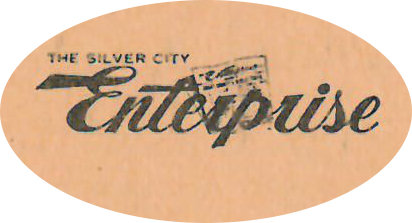

By Dorothy Watson
First Printing July, 1960
Second Printing August, 1960
Third Printing September, 1960
This Printing April, 1970
Printed by
The Silver City Enterprise
Silver City, New Mexico
Pinos Altos, the oldest Anglo settlement in Grant County, is a small town in southwestern New Mexico. It lies across the Continental Divide at an altitude of just over 7000 feet, between the Diablo Range to the north and east and the Pinos Altos Mountains to the south and west. Bear Creek begins in the Pinos Altos Mountains and flowing north divides the town, joining the Gila River near the town of Gila, twenty miles away as the crow flies. Whiskey Creek has its source in the Diablos, skirts the town on the east and by devious means finds its way to the Rio Grande. It is in a transitional zone where Ponderosa pine and junipers, pinon and scrub oak meet. There was a time when the site was covered with tall pines, when springs bubbled to the surface, and the arroyos ran with water. Ruins of pit houses and the number of shards and artifacts found in the vicinity indicate that a prehistoric people lived here before the coming of the white man.
In the archives of the Mexican Government in Chihuahua, it is said, there are records of the discovery of gold in the Pinos Altos Mountains by General Pedro Almendaris, a commandant at Santa Rita, and of shipments of gold received there from San Domingo Creek in 1837. The laborers at Santa Rita were convicts for the most part and a small garrison of soldiers was stationed there to guard the convicts and also to protect them from the Indians. No doubt in the performance of their duties they scouted this far afield.
There is a legend that Mexicans finding gold here built a small but strong encampment of logs, rocks, and adobe which they called “Pinos Altos”. The wall was built in the form of a horseshoe with the only opening at the narrow end. Inside were shelters for men and animals and a living spring at the foot of a large cottonwood tree. Men and animals lived inside the enclosure but went outside every day and while the men placered the animals grazed. At day’s end the workings were carefully concealed and all returned to camp and barricaded the opening for the night. Day by day more gold was added to the rawhide panniers. At last the time came when the gold must be taken to Mexico. There is something about the precious metal that incites greed and envy. The men disagreed as to whom would take the gold to far away Chihuahua, and who would stay to protect the camp and continue working. Each man distrusted the other. The story does not tell what happened—whether all went and were ambushed and destroyed by the unfriendly Indians, or whether while they quarreled the Indians found them with their guards down. Perhaps like “the gingham dog and the calico cat”, they “ate each other up”. The story simply ends by saying that they disappeared and that nothing was left but the horseshoe-shaped ruins around the spring at the foot of the cottonwood tree. Such is the legend of Pinos Altos Primero.
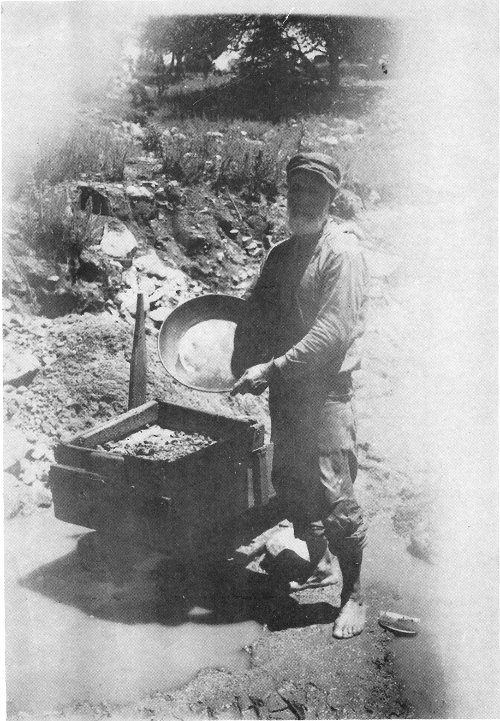
Old Juan Esquijedo, “One-Armed Juan,” shows gold in his pan. In one season Juan filled a large beer bottle with gold from Arroya Rico. That was in the good old days.
Early one spring a party of twelve scouts left Tucson for the Rio Grande. When they reached Mesilla they decided to prospect in the mountains to the northwest. They stopped in Santa Rita to replenish supplies and then moved westward. On May 18, 1860, three prospectors, from that party, named Birch, Snively and Hicks, camped on what is now known as Bear Creek. Birch went to the stream for water and found chispas—small nuggets of gold, in the bed of the stream. Scooping up a handful he returned to his companions. Then began a frantic exploration of Bear Creek and every nearby gulch. Their findings were sufficient to justify the establishment of a more permanent camp but additional tools and supplies were needed. They went to Santa Rita where they confided their discovery to the Marston brothers and Langston whom they found working there. Returning, they christened their camp “Birchville” in honor of the discoverer and erected structures more adequate for comfort and protection. They were joined by the three Americans who knew of their discovery, and by many others, both American and Mexican, for the secret was out. By September there were 700 men in the field and a few families of the Mexican miners. While Santa Rita could supply staples, it was necessary to go to Mesilla for hardware, clothing, groceries in quantity, which they paid for with 1 · 2 or 3 fingers of gold. The first year was spent placer mining and prospecting to find the “mother lode”. The Apaches were very troublesome, confining their activities to waylaying small parties, the driving off of stock, and to gathering on the hills above the workers, taunting the “Goddammies” as they called the Americans, from the words heard frequently from the men. The second year a few lodes were located but only the surface was scratched. Quartz bearing ore was crushed in arrastras, century-old mills such as the Egyptians and Phoenicians had used to crush olives for oil and grapes for wine, and which had come down through the ages to the Mexicans. A circular pit was dug, sides and bottom lined with flat stones, a stout pole was placed in the center to which an arm was attached and a burro, mule or horse could be hitched. Heavy rounded boulders were placed in the pit and attached to the other end of the arm. The quartz was thrown into the pit and broken up as the beast walked around and around. The rubble was thrown out and the bottom scraped of the fine material which was then washed in the ordinary rocker. (Only one arrastra in good condition is intact today). As more and more miners came in the settlement moved up the creek to a more central location for all placer grounds. The Mesilla Times in 1861 carried items and advertisements from the gold camp. It stated that “Thomas J. Marston was pushing ahead his work of grinding quartz and doing well although constantly annoyed by Indians,” that, “The Pinos Altos Hotel served bread and meals,” that “Samuel G. and Roy Bean (Law West of the Pecos) were dealers in merchandise and liquors and had a fine billiard table”, and that “Thos. Marston wanted 200 quartz miners at $1.00 and $2.00 a day.”
With the establishment of the Confederacy this part of the West was claimed by the South. On August 1, 1861, Col. John R. Baylor as Governor at Mesilla, proclaimed the establishment of the Territory of Arizona. This included the part of New Mexico below the 34th parallel. Miners had been asking the United States Government for military protection but little action had been taken. However, Governor Baylor recognized the importance of controlling the Indians and of protecting the scattered inhabitants. Captain Snively’s Arizona Guards were assigned to watch the Apaches under Cochise and Mangas Colorado, and Thomas Marston was named Captain in the Arizona Scouts with nine men under his control to protect Birchville. At the same time he appointed Justices of the Peace for Dona Ana County, which then included Dona Ana, Luna, Hidalgo and Grant. Among them was M. M. Steinhal of Birchville, who became the first Justice of Peace in what is now Grant County. The Apaches were determined to drive all Americans from their land. Cochise brought his warriors from the Chiricahuas and joined Mangas Colorado and his Mimbrenos for a concerted attack on the miners. Cochise was in command. Early on the morning of September 22, 1861, 400 Apaches made a bold, but unsuccessful attempt to destroy the camp and drive the miners out. The conflict raged along the Continental Divide until one o’clock, when with fifteen Apaches killed, one by a dog belonging to a Mexican named Carlos Norero, the Indians withdrew. Three Americans lost their lives, including Thomas Marston who had been fatally wounded and died a few days later. He was buried beneath the large juniper tree in the Pinos Altos cemetery. Many of the remaining Americans decided that their scalps were more valuable than gold and left to join either the Union or Confederate Forces. The Beans were among them. On October 10th Governor Baylor responded to a desperate call for help from the weakened settlement by sending a detachment of 100 men under Major E. Waller to relieve the miners and to protect their rich workings.
Not all the trouble during the year 1861 was with the Indians. A man named Taylor held a grudge against William Dike, who was in the employ of the Overland Express Company. At a baile on Christmas Eve, Taylor gathered some friends about him and fired at Dike, who was dancing. Several shots were exchanged, Dike was killed and Taylor wounded. However, he was able to escape into Mexico. This was the first murder in the camp.
Jack Swilling, who had been among the first people to come to the camp, enlisted with the Confederate Army, was commissioned a lieutenant and assigned to protect the settlement. He was very popular with Americans and Mexicans alike. He had been friendly with Mangas Colorado and once was accredited with saving the chief’s life. One night, in a drunken brawl, he shot and killed his best friend—a man named Printer. This friend was buried in the cemetery near Captain Marston but his grave was not marked. People of the camp, thinking that Swilling’s shock and grief were sufficient punishment, did nothing about the affair. Later Swilling went to Arizona where he started the development of the Salt River Valley. However, when in 1867, Dan Diamond, over a trivial matter and in cold blood, killed Schwartz, a butcher, the men took action. 7 The nearest court was at Mesilla so they decided to give Diamond a fair trial. He was permitted to select his own jury and a man to defend him. He was found guilty as charged and sentenced to hang. Sunrise next day saw him hanging from a large juniper tree on the “Mill Site.”
Mangas Colorado was a wise and worried chief of the Warm Spring Apaches, and he was getting old. He had watched the hard rock miners at Santa Rita and the slow-moving pipe-smoking “Los Goddammies” in the arroyas in the Pinos Altos mountains and noted that they came in ever increasing numbers, that every day parties of hunters were killing deer, antelope and turkey and driving game farther back into the mountains. He wondered what would become of his people. He went to parley with the miners and learned that they were interested only in obtaining the bright metal. In an effort to get them to leave the country he offered to lead them to a rich gold field south of the border which Victorio had found. On one occasion he was bound and whipped, which he said he “could never forgive”. As he was let go one husky miner, who had been tormenting him, called, “Send over Apache girls, no whip their backs”. He went to a secret place where he rested and recuperated from his injuries, sick with humiliation and bitter about the loss of his son and of his friends through the treachery of the Americans. A plan formed in his mind. Returning to Warm Springs, he began his preparations. He sent for Cochise “Not for war but for counsel”. Cochise told of long wagon trains coming into the country with more and more men. If ever the miners were to be driven out now was the time. Cochise returned to his mountains. Mangas Colorado had the herds brought in and driven to secret places, braves and women were given instructions, and suddenly Warm Springs was deserted. One day, on the long slope above the miners’ camp, a bevy of Apache girls and young squaws appeared. They paid no attention to the settlement nor to the miners who were working nearby, but combed and braided their long hair. Once in a while the girls left the group to run and play among the rocks and then went back to combing their hair. The miners called to them but they did not answer. Evening came when all the miners returned to camp. The sight of the women so excited the men that they forgot their camp chores and charged up the hill. At the same time the mules were stampeded, hunting parties that had been out for game for the camp were ambushed, and a volley of shots came from across the canyon. Forty of the miners were killed or wounded. One hunter who escaped the ambush reported that an overwhelming number of Apaches were in the wooded hills. Apache like, they did not follow up their advantage but withdrew. This episode and the War between the States caused more of the Americans to leave. “They will come again,” said Mangas Colorado.
Word was sent by General Carleton at Fort Bowie to General Joseph West to arrange for the capture of “the bloodiest of Apache chiefs”, to “take him dead or alive, by force or strategy”. Captain Shirland, with the aid of Jack Swilling, located Mangas Colorado in the Pinos Altos Mountains. When told that General West wanted to have a peace talk with him, the chief went willingly and without his warriors. On January 17, 1863, he was taken as a prisoner, to 8 Captain Shirland of the 1st California Cavalry at Fort McLane. The official records say that “he was killed the following day by a guard while attempting to escape.” The records in Washington also stated that “the wife of Mangas Colorado was killed, along with ten other Indians by Captain William McCleave, of the 1st California Cavalry at the Pinos Altos Mines on January 19, 1863”.
The next year an enterprising young man, Pete Nest, left camp to go to El Paso where he bought a barrel of whiskey. All went well on his way back until he reached the creek east of camp where he had a breakdown. He managed to get word in and the boys went down the trail with their tin cups. Nest said that he netted about $800.00 in cash and gold. There are many stories of how the creek got its name but this one is most reliable. Many years later the good people ranching down the valley petitioned the legislature to have the name changed. The bill was introduced by the senator from this district. Some wag suggested “Cedarbrook”, that being the senator’s favorite brand. The name was changed to Arenas Valley but the people at this end prefer “Whiskey” to “Arenas” (sand).
There was a strong feeling of enmity between the Southerners—most of whom had come from Texas—and the Mexicans. In February of the following year a dispute about the locating of mining claims arose. The Americans insisted that the Mexicans should not be allowed to locate claims along the main gulches. The Mexicans, believing themselves to be the stronger group, made plans to take the camp. Don Manuel Leguinazabal prevailed upon them to desist so what might have been a bloody conflict was averted. The Indians continued to attack small parties and to steal stock so the two groups forgot their differences and united against the common enemy. For many months there were no major calamities for the Mexicans had made a treaty with the Indians who frequently came to the camp to beg for tobacco or to trade. Some bright mind conceived the idea late in the summer of ’64 to have a fiesta to celebrate the treaty of peace and to invite the Indians. A fine dinner of beans and other dishes was served to sixty Apaches in a house, since destroyed, but which stood near the present home of Miss Recene Ashton. While the beans were being enjoyed the dastardly hosts opened fire, killing several of the guests, others escaped with all trust in the settlers destroyed. Woe to anyone who wandered from camp from that time on. Virgil Marston took a chance and was killed on Whiskey Creek. He was buried beside his brother. But the danger did not keep other men from coming. After the war many of the men who had gone to fight came back.
When the California Column had been disbanded at Mesilla many of its members came to the settlement as “Indian fighters” and to make their fortunes in the gold camp. In 1866 the name “Birchville” was changed to the original name of “Pinos Altos”. To many the climate and the beauty of the country made a strong appeal and they considered making permanent homes. There were no American women in the settlement so many men took Mexican and Indian girls as their common law wives, built log or adobe homes and founded families that have been prominent in the history of the Southwest. Perhaps a touch of homesickness made them yearn for familiar things. They sent to former homes for seeds and trees 9 and planted orchards, vineyards and gardens on their claims where they had built homes. Some did not stake out claims but built on open ground, holding it by “Squatters’ Rights”. Messrs. Houston and Thomas located several claims down Bear Creek and made of the home place a garden spot. Their apple orchard was the first in Grant County. Moore, Stanley, Barton, Adair and Handy also planted orchards and vineyards. There were fields of alfalfa, corn and beans, and smaller plots of garden truck and flowers. Besides his terraced grape vines and fruit trees Mr. Stanley had a rose garden. The Mexicans planted almond and peach trees around their homes and invariably had oleanders in wooden tubs. During the summer they blossomed beside the doorways and somehow room was found for them inside the small dwellings when frost came. They took fledgling mocking birds from nests and carefully tended and trained them. They were kept in large cages hanging outside on the wall or from a tree where they called and exchanged confidences with the neighboring birds or complemented the guitar music. Each home had a small corral for the burro. Chickens and cows roamed at will and here and there goats would clamber over walls and roofs. Every day the yard was swept as clean as the mud packed floors of their dwellings. Peter Wagnor and John Simon brought wild roses from the canyons and planted hedges of them around their homes. Although the buildings were crude the general impression was pleasing. While this was begun in the late 60’s it stretched over many years.
A band of Navajos succeeded in driving off 31 yoke of oxen belonging to Hartford and Groves on the night of June 16, 1867. A company of 50 men under the command of Richard Hudson, (a member of the California Column and an uncle, by marriage, of Mrs. Robert K. Bell) took the trail and followed it for eight days before they came upon the band. In the running fight thirteen Navajos were killed and seven taken as prisoners. Hudson reported that one of his men had a cheek grazed by a bullet. This is the only record of the camp being raided by any Indians other than Apaches.
After the war the policy of the government regarding the West changed. The point that affected the Southwest most was the establishing of forts to protect travel and trade—even to protect the miners at Pinos Altos. In the general field orders for the establishing of forts it was stated “that one was to be in the vicinity of Pinos Altos, to consist of one company of infantry and two of cavalry to protect the miners of southwest New Mexico from the Warm Springs Apaches.” The Military Reservation of Fort Bayard was established in 1869.
All during the ’60’s supplies had to be brought in by pack trains over rough trails. The 10 mile trail to Santa Rita was the most direct line crossing above present Fort Bayard and across the mountains to Whiskey Creek. The pack trains from Mesilla left the main road to Santa Rita at Fort McLane (Apache Tejo) and came straight to camp. Game was plentiful but hunters had to be sent out daily to keep the people supplied with meat. It was never safe for one man to hunt alone so small parties took turns with the understanding that the venison, bear and other game would be shared by all. The Hill Brothers left the camp to ranch on the Gila 10 at what was known for years as the Hill and later the Gila Hot Springs (now Doc Campbell’s). There they raised vegetables and made jerky of venison which were brought to camp. James McKenna, author of Black Range Tales, engaged in such trade. The miners made periodic trips to the springs to bathe and sweat out the grime, smoke and the effects of bad whiskey. In 1868 Ancheta had a trading post in the original part of the old store building which burned in 1957. The handmade wrought iron box found in the ruins may have been his strong box. That same year he operated an arrastra, the remains of which can still be seen on the “Mill Site” now belonging to L. E. Nichols.
Mr. Robert K. Bell, as a boy, lived at the Ancheta Ranch, (the Ward Lodge in Little Cherry) and he told the story of the original stone house. Sr. Ancheta had taken up land near the Twin Sisters and had a goat ranch. This land is said to be the first land patented in Grant County. Ancheta went to Mexico for a visit and was a guest at an hacienda where he fell in love with the wife of his host. He persuaded her to run away with him and come to Pinos Altos. The house was built for her. The port holes were designed to keep off the pursuing husband and relatives as well as the Indians.
There was no formal organization, nor survey made of the camp until 1867. Anson Mills, later a prominent figure in the history of El Paso, was sent by a member of the famous Maverick family to make a mineral survey and report of this district. Evidently Mills’ report was not satisfactory to Mr. Maverick for he took no further interest in this section but Mills stayed. The residents felt that to make their rights to improvements secure they should take legal action so a Pinos Altos Town Company was organized. It had hired Mills to survey and plot the town conforming to government survey lines. According to the file in the county courthouse, transferred to Grant from Dona Ana, “streets had been laid off and graded, four bridges built over Bear Creek, and some wells sunk”. The file also states that “The first settlement had been made in 1860. In 1868 it had 600 to 700 inhabitants, 120 houses, two stamp mills, a number of arrastras, three furnaces for smelting silver, two hotels, and several mercantile establishments.” Incidentally, there were seven saloons, but instead of being listed separately they may have been classed as “mercantile” establishments. “The town embraced 320 acres, twenty miles from the Gila River and 110 from the Rio Grande by the nearest traveled road.” The town company was incorporated and the deed signed by “Samuel J. Jones, vice president, acting for persons” and dated July 3, 1868. Grant County was formed from Dona Ana that same year and Pinos Altos was made the county seat, 1869-1871. The county’s first court house is now owned by Mrs. Mabel Eckerd of Lordsburg. Only one term of court was held, presided over by Judge H. B. Johnson. It has been described as “the gayest and loudest ever held in the Rocky Mountain region.” A band furnished music, refreshments were handy, and two condemned men were taken out and hanged from the same tree where Dan Diamond met his fate.
Trolius Stephens brought his wife overland by mule train from Nebraska in 1873. She was the first, and for several years, the only American woman in town, excepting Miss Parker who had 11 been here eleven years before. They were the grandparents of Cecil Stephens of Arenas Valley. Both Mr. and Mrs. Stephens were interested in welfare of the people, they visited the sick, cared for the injured, and saw to it that no family was cold or hungry. He contended that a man was worth but $1.25 a day from the neck down but that there was no limit to his worth from the neck up. He paid accordingly. He could not or would not tolerate stealing. On one occasion when he noticed that wood was disappearing from the town’s large wood yard, and the man in charge of it said that he did not know how, when, or by whom, Mr. Stephens said he would “fix the guy.” He bored holes in several sticks of wood and put in dynamite. Before sunrise the next morning a mighty blast shook the town. Mr. Stephens rushed out and saw a roof rising into the brightening sky and above were several black disks, the lids from the kitchen stove—in the home of his cousin.
Fuel for homes and mills was juniper and oak wood cut in the hills into cord lengths and packed into town by burros. Ore from the mines was taken to the mills in the same manner. Often there were as many as twenty burros to a train. The trails they used still stand out on the mountain sides, as do the old roads from the saw mills, where the logs were hauled out by oxen. Among the names of men who operated early sawmills are Ripley, Scott, McMillan, Brownell and Franey, who came in ’81 or ’82. He was joined in 1902 by his nephew, Thomas Foy, a rosy cheeked boy fresh from old Ireland. Later there were Davidson, Slack, Leonard, Mason and others.
From the earliest days when both Mexicans and Americans traveled through the country they would camp at the springs the Mexicans had called Cienega de San Vicente. Miners from Pinos Altos tried raising corn and beans there, but being loathe to leave their diggings to care for the crops, Indians or animals destroyed them. Captain A. J. Hulburt, more daring and persistent than other miners, built a cabin and took his Mexican wife there to live during the growing season. He would ride to and from his mine, the “Texas” on the western slope of the mountain, a distance of seven miles. One day he left his rifle at the cabin with his wife and son and went out to plow his field. Looking up he saw Apaches between himself and the house. Knowing he could not rescue his family he ran to the mines, hoping his wife would be able to stand off the marauders until he could get help. Almost exhausted he gasped out his story. The men grabbed their guns, mounted their animals and hurried to the cabin, only to find it smouldering, the wife and son dead, and the Indians gone.
When this place was selected as a town site in 1872 and was named “Silver City”, Dick Hudson remarked, “That’s a hell of a name to give a town on a mud flat.” Later he wrote, “The only rival the Tall Pine City is ever destined to have sprang into existence as if by magic”. He was wrong in his use of the word “only”. A quarter of a century later a writer in The Enterprise referred to Pinos Altos as “an abandoned camp in Silver City’s back yard”. He, too, used one wrong word—“abandoned”. The opening of mines to the south and west drew many miners away and more adventurers were attracted to this district. Many of these men wanted to get rich 12 quick and engaged in illicit mining deals. The result was that many claims were not being worked. The newcomers were more inclined to gamble than to use a pick and shovel. It was helpful to have a nearer source of supplies but the cost was just as great and business declined. In those days ox teams would leave Pinos Altos in midmorning and camp at the Half-Way Rock for the night. Early the next morning they would proceed to Silver City where the wagons were loaded, then they came back to the Half-Way camp and on to Pinos Altos the third day. Once a band of Apaches attacked but were unsuccessful. Another time they swooped down on the stage between the old Brent Ranch and Pinon Hill, wounding the driver and killing one mule. “Chinamen” were among the passengers and they put up such a good fight that the Indians rode off. Old “One-Armed-Juan” Esquejeda told of having goats taken from his place almost in the center of town and about the same time Willie Fletcher and some of his pals went swimming in a pool formed by a dam in Arroya Rico. Their scattered clothing was left on a bank. A group of young braves came down the gulch and stood watching the splashing boys. They gathered up the clothing and departed. The boys waited until dark before slipping home. Some time during the ’70’s Silvario Gutierrez returned to his family after having been a captive of the Apaches for seven years. His family had given him up for dead and although he had been very small when captured he, fortunately, remembered his “pet” name. He was the grandfather of Manuel Gutierrez of Santa Rita and of Virginia Terrazas and Nora Garcia.
Placer mining no longer yielded such rich returns. Many placer and lode claims were abandoned, and except for gambling and dance hall brawls things were considered quiet during the ’70’s.
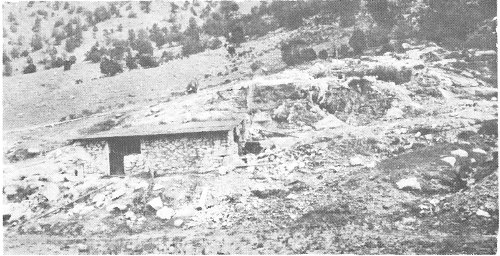
For nearly 100 years people from Pinos Altos have gone to the Upper Gila for rest, recreation, hunting and fishing. The Hill Brothers built this bath house to accommodate the grime-coated early day miners.
The next two decades were of increasing prosperity, thanks to the efforts of Trolius Stephens and Nathaniel Bell. Not only was there greater mining activity but new businesses were opened. The Ancheta Trading Post had been bought by Bell and Stephens and enlarged into a general merchandise store which handled everything from hair pins to machinery. They subsidized a drug store, a barber shop, and a meat market which had its own slaughter house. Other merchants opened clothing stores—general and “for men only.” The town boasted a band, a baseball team, and a Turkish Bath. Two new hotels were built—The Palmer House and the Pacific. New and larger homes were erected, more orchards planted. Trees, many of them maples, were planted along the streets. Because animals roamed into town, each tree was enclosed to the height of five or six feet. More saloons and gambling halls were added until they numbered fourteen. There was no “red light” district but “fancy ladies” came up from Silver City every pay day and two houses were their headquarters. Whenever a Mexican family could serve enchiladas a lantern would be hung outside. Mrs. Handy’s lantern would be out every Saturday night. Her enchiladas were considered the best made any where and her Arbuckle coffee was ambrosia.
So great was the influx of new arrivals during the ’80’s and ’90’s that two stages—and sometimes more, made regular round trips to Silver City to carry passengers and mail.
Chinese had been among the early settlers and they lived in dug-outs along the gulches. They foresaw that cooking for the miners and washing for them would be more profitable than placering so they discarded their gold pans for dish pans and wash tubs. Many stayed for years operating eating houses, laundries, and hop joints. See Hop was a general favorite. He loved children and was always ready to “baby-sit”. No baby was born but See Hop went to see it, bearing a gift. On the Chinese New Year he would distribute Chinese candy and lichee nuts to the children and Chinese lily bulbs to the mothers. He had a wife and children in China and his ambition was to make a fortune and return to them. He lost his first savings in the failure of a Silver City bank so would not trust his money to a bank again. He hid it in his house and was robbed. Later, in Santa Rita, trusting neither house nor bank, he buried it and a flood washed it away. Again he started saving and when he had enough for passage he went home to China—an old man. While he was in Pinos Altos he decided that he would like to give up his laundry and go into the chicken business. W. E. Watson bought the chickens to start him. All went well for a time then the chickens began to die. Nothing he did changed the situation. Papers with Chinese characters on them were posted on all gates and doors. The chickens continued to die. A Mexican came by and asked about the papers. See Hop told him they were notices to the evil spirits. The visitor laughed and told him to put crosses on every high point where they could be seen because the devils here could not read Chinese. Still, 14 no desired results. In despair See Hop went to the one who had bought the stock in the first place and said, “You write letters to the bad spirits in English. Say they belong to Billy Watson. They do not know Chinese and they do not understand crosses. You tell them.”
With so many animals needed for power and transportation corrals were built at the edge of town. “Bob” wire had not come into use but there was plenty of bailing wire—“one of the two good things,” the Indians said, “that the White Man brought into the country.” Juniper posts in an upright position were set into the ground as closely as possible and wired together at the top. There were miles of such fences to enclose the oxen and burro trains. There were livery stables, carpentry shops, planing mills, dance halls, and from the very beginning, the necessary blacksmith shops. “The Pinos Altos Miner” made its appearance on July 11, 1888, with Mr. John C. Bayne (grandfather of Clarence Bayne of Silver City) as editor. Mr. Bayne had been attracted by reports of the mining activity and came expecting to mine, but having been a newspaper man he could not resist the appeal for a local paper. It was published for several years. Later “The Pinos Altos,” a strictly local and mining journal, of which Galloway and Warner were the proprietors, was published.
Mr. George D. Lincoln left Silver City to open a law office in Pinos Altos. One of his clients was a man known only as “Adobe Bill”. He had a Mexican wife and several children. Being unable to pay the lawyer’s fee in gold or cash, he gave his two sons to Mr. Lincoln who refused to accept them as payment. One day the sheriff came looking for “Dobe Bill”, and everyone thought the law had caught up with the man, but it turned out that he was William Ferris and he had inherited a large sum of money. “Dobe” sweated years of accumulated grime out in a Turkish bath, had a shave and a hair-cut, bought himself the loudest suit to be obtained, deserted his family, and departed.
Many nationalities were represented, and until the ’80’s they mingled freely. When Bell and Stephens advertised for “hard rock” miners, a Cornishman told Mr. Stephens he knew a good man, his “Cousin Jack in the Old Country”. “Send for him,” Mr. Stephens said. Cousin Jack came and he had a “Cousin Jack.” Soon the “Cousin Jacks” were flocking in. It was natural that they should get together. They built their homes up the hill to the southwest of town—seven or eight houses clustered about a large rooming and boarding house run by Mr. and Mrs. Noah Climo. People down town referred to it as “Cornishtown”. The Italians formed their group and selected a site to the west. It was known as Italian Town. The newer Mexicans were allowed to build only on the outskirts. They choose the Continental Divide and the ridge to the east of town where they had hand-ball courts and cock pits. No longer did the groups meet socially. The Mexicans had their bailes and fiestas, from which, unless he was there by special invitation, a “white man” was thrown out. The American group included all not Spanish-speaking. They had their balls in the new hotels, whist and sewing clubs, dramatic society, and lodges. Saturday night was “sluff” night at many saloons, and men who did not frequent saloons at 15 other times enjoyed their weekly games. There were horseback rides, taffy pulls, tea parties, and picnics. Ladies of long residence, dressed in their best, raised their parasols and called on newcomers. Life, if not exciting by today’s standards, was very pleasant. On summer evenings parents sat rocking contentedly on the front porches with their daughters wistfully sitting on the steps listening to calls of “Lie low” and “Run, Sheep, Run” from the boys in all parts of town. In the winter they sat around sheet iron stoves, mending or reading, while the children did their home work around the dining room table.
Nathaniel Bell went to Wisconsin and married the girl he had left there years before. Red-haired Sue Bell was a welcomed addition to the town. She was friendly and had a knack of starting things and seeing them through—the first community Christmas tree, for example. Mr. Bell had lost a considerable sum in the first bank failure, and although he was distrustful, he deposited money in the second bank. When it, too, closed its doors, Mrs. Bell said, “The money is yours. Go and get it for I’m sure the bank president has it in his home. I’ll be standing by.” Bell went and was told by the wife that the president was ill and could see no one. Bell said, “I have come to see him and to get my money. Either he comes out or I go in.” The bank president came out, took one look at big Nat Bell, went to a wall safe and took out $10,000. Bell and Stephens were the only operators that met their payroll that month. But he was through with local banks. Thereafter he buried his money, keeping a record on the jamb of a pantry door. One day the storekeeper saw a Mexican, who was digging around the fruit trees in the yard, lean over and pick up something. He looked around, dropped his hoe and took off. The storekeeper leaped over the counter, called to a clerk that he was leaving, and sprinted after the man, overtaking him in an alley. The Mexican handed over his find—a large tomato can that had been opened with a butcher knife and the points pushed together again. It was filled with coins and a sticky mass, indicating that it had been in the ground through many storms. With a warm iron and blotting paper, Mrs. Bell was able to distinguish green backs. She sent the mass to Washington and received more than two thousand dollars in new bills. Mr. Bell had made no record but he was able to recall the circumstances. The day he collected the money no one was home, he could find no other can, so he buried it hurriedly, thinking he would find a better container, then had been called away. The incident made him think that perhaps he had failed to record other deposits so Mrs. Bell superintended the digging up of the entire place. Two more cans were found but of the baking powder variety. That started everyone digging for buried treasure and some was found.
George H. Utter, before he engaged in mining, sold Singer Sewing Machines. He drove about the county in a buckboard with a machine for demonstrations tied behind the seat. He came to a Mexican ranch on Whiskey Creek just east of Rocky Point the day after the rancher had found a can of gold. He had invited several of his friends to help him celebrate and they were making merry when Mr. Utter drove up. The women “Ohed and Ahed” over the 16 latest model. The man showed the gold to Utter and ordered a new machine for every woman present.
Edward Dehaney was a very likeable young man but described as “not worth $1.25 from the neck down.” His worth was from the neck up as he proved later in his career. While he was in Pinos Altos he was practically penniless but full of schemes. The Bells took him into their home and boarded him for several months with the understanding that he pay when he could. Mrs. Bell knew he was receiving money but he never paid a cent and left town without doing so. Mrs. Bell collected years later. When she visited him in his pretentious offices in California and presented her bill he said, “But, Mrs. Bell, this is outlawed—and you, being a lady, would not presume to collect an outlawed bill.” Mrs. Bell replied, “I know the bill is outlawed, but you, being a gentleman, will surely honor it.” His check went to a home for old miners.
When the first son was born to the Bells he was given the family name of “Golden” and his father had a bell made of local gold which Golden wore on a chain around his neck until he reached school age. A gold brick from a run of the mill was kept on a counter in the store. The early miners used gold as a medium of exchange as long as they lived. It was usually carried in a small Bromo Seltzer bottle in a pocket and a man could estimate accurately the amount for his daily needs. As he grew older, if he needed 60 cents for coffee and tobacco he washed out that amount, if he needed $4.50 for overalls, blouse, flour, sugar and meat, he panned that amount, then sat in the sun. Goods were no longer paid for by the “finger” for the gold was carefully weighed. Should the amount of gold be a little more than the bill, candy would be taken home for the children. If it fell short a tab was made and dropped into the till. Rarely was it necessary, and always when the man came back to make another purchase, he would have extra gold so the tab against him could be destroyed. In those days there were no pennies and very few dollar bills in circulation. All costs were figured in multiples of five and reduction in price was given if items were bought in quantity. Men who worked for wages settled accounts on pay day and went home with a generous sack of candy. Store hours were from seven to seven. Usually there was a dull period in the afternoons which the clerks used to put up beans, rice, and sugar, etc., in 25c and 50c amounts, folding and tying the sacks for the evening rush. Saturday was clean-up night when the delivery boys, clerks, and handy men would take off their shoes and socks, roll up their pantaloons, and with brooms, mops and buckets of hot soapy water, scrub counters and floors. The Bell and Stephens store was the largest but it was a company store. Smaller companies and independent operators wanted other stores. Neffe had a store at the corner of Main Street and Gold Avenue—later the F. J. Davidson store. Men who worked at the Mountain Key and at the Golden Giant traded there, and later the Mammoth people. The building which housed George Norton’s store is still standing, south of the Buckhorn Bar. Both buildings are relics of the ’70’s.
Many men like Jim Hill and his brother had taken up homesteads on the Upper Gila and along the Sapello. They traded in Pinos Altos and drove their cattle through town to the stock yards 17 below Silver City. Merchants waited six months or a year for those accounts to be settled but they always were. One rancher, in for supplies, would take out coffee, tobacco and mail to all along his way. Newspapers, no matter how old, and magazines were always welcomed in the remote areas. Each merchant had a collection box for them. The corrals at the stores were open to the ranchers and often they were filled with pack animals. Trappers and government hunters also camped in the corrals. Ben Lilly and Nat Straw were regular visitors and once in a great while “Bear” Moore would come to town. Moore had lived in a cabin at the mouth of Big Cherry before he moved to the West Fork. He had been badly mauled and disfigured as a result of an encounter with a bear and had withdrawn from contacts with his fellow men as much as possible. As he told his story, he had killed a half-grown cub in a rocky canyon when the mother appeared around a bend. Moore’s gum jammed and the bear was upon him. He fought with sticks, stones and his bare hands, unable to escape. When he regained consciousness the dead bear was lying beside him and Moore was torn to pieces, a jaw bone and part of his breast were gone. Looking down at the gaping hole he said that he could see his heart beating. That he was able to crawl to camp and receive help was miraculous. His last years were spent prospecting in the headwaters of the Gila country and it was rumored that he made a rich find. When his last camp was found Moore had been dead for some time. A handful of beans, the remains of a shank of venison, a canvas bag containing worthless rock was all that was found. The old hermit had died of starvation and exposure.
The Hearst Company renovated the store with paper and paint, arranging the stock into departments, as drug, dry-goods, hardware, etc. A large sheet iron warehouse was added for rails and other mining equipment. Also erected was an office building, a mess for office and store employees, and new homes for their foremen. The Bell and Stephens duplex was remodeled for the Thayer and Risque families. Altogether the old town had a new look. Stephens, before he would sign the sale papers, had insisted that “his people” be given consideration and cared for, and the Hearst Company carried out this policy. “Chan” Derbyshire was promoted to be store manager and promising local boys were changed from common laborers to store clerks—Tom Hall and Fernando Chavez were two of them. Will Rivers and George Turner came from Silver City to take positions. Among the men who were brought in were Harry Thorne, assayer and Mike Riney, master mechanic.
When Bell and Stephens had announced the sale of their property to the Hearst Interests there was great excitement. The Hearsts represented money and money could do great things, but at the same time, they were sorry to see the Bell and Stephens families depart. The property had been turned over when Mr. Daniel B. Jillette, Jr., representing the Hearst Interests, presented Mrs. Bell a farewell gift, the last ingot from the Bell and Stephens Mill. This gold has been used only for wedding rings and from the amount remaining today it will furnish wedding rings to the Bell family for many, many generations.
There must have been doctors here before the ’80’s but they left no records. Dr. Lewis B. Robinson came to take charge of the drug store and to care for the ill and injured. He was a character, crude in his methods but a family physician of the old school, ready day or night to go where ever needed. He would go to a home just to see the folks, have the children stick out their tongues, sometimes leaving pills or asking them to go by the drug store for a powder. There was a “pest house” where victims of small pox were quarantined. Once the case was confined there was improving and had gone outside to sit in the sun, when he went inside he found that his bedding had disappeared. When “Doc” was informed he said, “Well never mind, we’ll know who took the blankets in a few days.” Sure enough, Joe Acosta came down with the small pox and was marked for the rest of his life. Other doctors came and went and for a time there was a dentist with his own office and equipment, but usually the inhabitants depended on the semi-annual visits of Dr. W. H. White of Silver City to have dental care.
The climate attracted health seekers, particularly those with tuberculosis. Most followed a rest cure, others tried to work, some went out to ranches. It is recalled that one young man would go to a slaughter house whenever a beef was to be killed and drink a cup of warm blood. Some went home to die, others were shipped East, but there were others, like Russell Davidson who came from Nova Scotia and was taken from the train on a stretcher, who lived a long and active life. William Sweikert was a health seeker (1908-1911) who was interested in the native population. He was Justice of Peace and as such, came in contact with some quite often. He was shocked to learn that many families had not been married so he rounded up the men and women involved and persuaded them to get licenses and he would perform the civil ceremonies. When that had been done, the next step was to have the marriages blessed by a priest. All friends and relatives gathered, children dressed in new white dresses or blue jeans formed a procession to the church. “Un Gran’ Baile” was held and the bridegrooms broke “carones” over the heads of the gray-haired brides with as much ardor as much younger gay caballeros would have done.
Soldiers from Fort Bayard had always ridden across the hills, at first on duty, then to call on the pretty girls. Many passes were issued because of a party or a dance. However, the girls were choosy and not all soldiers were welcomed. They were admitted to other places, however, and their trails could be followed by the “dead soldiers” (large brown beer bottles) lying along the way. There were plenty of attractive young men in town and the homes where there were girls were hospitable. A favorite song among the boys was:
“Let’s all go up to Maud’s
We’ll have a jubilee.
Make love to all her sisters, boys
But please leave Maud to me.”
They had the Lee home in mind where Mrs. Lee was even more popular than her four daughters.
Henry Young and his brother, John, about 1900, sold their ranch above Fort Bayard and came to Pinos Altos where they built a livery stable. Henry is remembered for his tall tales of his own achievements. However, he was a hard worker and the results of his efforts often justified his stories. He had the fastest horses, the best equipment, he raised the best vegetables and fruits. He introduced the Stark Delicious apple to this section and won several awards for them at state fairs.
Each mining company had its own engineers, foremen, and laborers and their families joined the men. The community regretted seeing friends depart and at the same time they welcomed the newcomers. Often the change brought an outstanding person—such was Mrs. Grace Griswold Adams. She was a teacher in the Milwaukee Schools who had bought stock in the Savannah Mining Company. For a summer vacation she decided to visit Silver City where she could see something of what her mining stock represented. She liked the country and the people so asked for and was granted a year’s leave of absence. She took a position in the smelter office but was persuaded by Mr. F. J. Davidson to leave it and teach in Pinos Altos. She married George H. Bisby of a pioneer Lone Mountain family and lived here, teaching part of the time, for 36 years. She was an interesting conversationalist, being a keen observer and well-read. Her hobbies were music and painting, she was always ready for a bridge or a croquet game, and her home was always “Open House.” A Christmas party at the Bisby’s was something to remember.
When the town was particularly prosperous a Fourth of July celebration would be held. It began with the band parading to the speaker’s stand, the singing of the National Anthem, a prayer, and a flowery, stirring oration. Then came some events for the young fry—climbing a greased pole or catching a greased pig, foot races and a burro race. The Ladies Aid and the Catholic Women helped feed the crowd at noon. Restaurants served special menus and many ate picnic lunches under the trees. In the afternoon there was a baseball game on the regular ball grounds by the “Gopher” where there was a grand stand for spectators. The drilling contest would take place nearby on the rocks east of the Gopher dump. Fireworks preceded the dances in the evening, rounding out a grand and glorious day. Often bets were taken on the hour and minute that rain would fall. Summer rains generally started on the Fourth. The procedure was patterned after the wagers made in Alaska as to the time the ice would go out. The one giving the nearest time won the jackpot. The burro race was unique. Each youngster entered his own burro but rode one belonging to someone else. The slowest burro won, so every rider forced his mount to the greatest speed possible.
After World War I many discharged men settled here, partly for reasons of health and partly because they liked the place. Harry Hickel, Bob Riddle and Jim Bonnelly were among them. They loved the out-of-doors and shared in community affairs so they were interesting families to have as neighbors.
The young people among the new arrivals had to be initiated. If the young man was a tenderfoot he was taken “snipe hunting” but girls were treated in a more original fashion. They would be invited for a horseback ride to see the mines. The hostesses would rent horses from the miners who habitually stopped at the saloons on the way home from work. As the returning party approached town it was seen to that the horses were on their usual trails. In front of the saloons the horses would come to a dead stop. No amount of coaxing, whipping, nor under-the-breath cursing would make them move for ten minutes, just long enough for the owners to have their usual drinks. Then the horses lifted their heads and trotted to the home corrals. This may not seem funny now, but it was hilarious when a “nice girl” would not even glance at a bar room door. There were no hard feelings—it was just part of the wild and woolly west.
Pinos Altos was not a lawless place as old mining camps were supposed to be. There was a stout jail, first on the main street and then moved to the “Mill Site.” Offenders were not confined long. In early days if the crime was a major one justice was swift, and if it was a petty offence one night locked up was sufficient to sober the inmate. Mr. H. E. Muse was marshal for a time and his presence was enough to make would-be law breakers watch their steps. Ex-President Theodore Roosevelt, speaking from the steps of the Eckles home in Silver City on July 11, 1913, referred to a murder committed by one of his “Rough Riders” in Pinos Altos. The man had written for help saying, “he had killed a lady but thought he was shooting his wife.”
Mr. and Mrs. Peter Wagner had not been in America long when they came West during the ’70’s. Another French family came later and the two couples became close friends. When a baby was born to the second couple and the mother died, the Wagners took the baby girl and loved her as their own. Mrs. Wagner had been a lace-maker in Belgium and everything she made for the baby was trimmed with exquisite hand made lace. The Wagners wanted to adopt the child but the father would not give his consent. When the little girl was three years old the father left and took his daughter with him. Mrs. Wagner grieved until she became ill and after that was always considered queer. She would talk to herself and to her dogs but not to people. Besides working a mine and mill, “Pete” had a barber shop next door to John Oglesby’s saloon. Bob Close was a character who was very proud of his goatee. One day when he came into town he visited the saloon where he imbibed freely then went to the barber shop for a hair cut and a trim. He fell asleep in the chair and Pete went on to other business leaving him there. Some rascal saw him, slipped in and cut off the goatee. When old Bob awoke, from habit, he started to stroke his goatee. It was not there, nor was the barber, so he went raging into the saloon threatening to pound the little Frenchman to a pulp. Mr. Oglesby laughed and Bob accused him of the dastardly act, he swore and fingered his face, fighting mad. It took six men to subdue him and to assure him that the injury was not permanent. Wagner had invested in Silver City real estate and after his death Mrs. Wagner would walk there often carrying her shoes in her market basket, and after doing her shopping and collecting the rents would walk back. Mrs. Oglesby, 21 who sometimes drove the stage, was the only person she would ride with. Later Henry Geitz was appointed trustee. Once he and Mrs. Wagner made a trip to Europe together in an attempt to find relatives. Mrs. Wagner said the persons they found were too old and she insisted on returning. During World War I all trace was lost of the relatives of both Mr. and Mrs. Wagner. Once when the rent was being given her, Mrs. Wagner said that she did not want the money, that the can in the woodpile was full. Some time later she was beaten and robbed and died as a result.
Fights originated in saloons and dance halls more often than anywhere else. Arguments started that only fist fights or gun play would settle. Usually the participants would be thrown out before anything serious happened. One Christmas Day, Tom Gibson, having the fore-runner of the Boy Scouts’ good deed in mind, offered to tend bar while John Oglesby ate dinner with his family. The loafers thought they would have some fun with the “tenderfoot,” as they regarded Tom. John kept a gun beneath the bar and Joe Acosta went looking for it. Tom told him to keep away. That started the fuss. Tom thought he was going to need the gun but it was not in the usual place so he tackled the bunch and literally threw each one out including big Valentine Gutierrez. Tom was accepted as a right guy from that time. Some G.O.S. cowboys were on their way back to the ranch after driving a herd to the stock yards. They had been having a big time in Silver City and were still whooping it up when they arrived, dropped the bridle reins and entered a saloon. A newcomer was acting as constable that day, and carrying a shot gun. He went after the cowboys for disturbing the peace and escorted them to the jail. As he unlocked the door he was overpowered, the key and his gun taken and he was locked inside. The cowboys returned to the saloon and, leaving the key and gun, told Mr. Oglesby what they had done and cautioned him to keep the constable locked up over night. Old “Plunder,” another of the town’s characters, went to let the man out next morning and dubbed him “Shot-Gun Smith.” “Oh, but my name is Alexander Keys,” said the erstwhile constable with dignity—but “Shot-Gun Smith” was what he was called as long as he was in the vicinity.
Juvenile delinquency was never a great problem. Boys always threw rocks. If a house was vacated vandals took it over. It was “great fun” to tease Mrs. Wagner. It was rumored she always carried a butcher knife in her market basket. Joe Munoz was tormented just to hear him storm in fluent Italian. Joe had a small store with rooms to rent above it. When it burned two men died in the blaze and a Silver City paper reported “that 10,000 other lives were lost”. Bed bugs. It is recalled that just after the Waterburys and their associates had gone, leaving a caretaker at the property, some youngster at school suggested that, since the caretaker was out of town for the day, it was a good time to have a swimming party in the Mammoth tank. He had seen the Waterburys swim there and he knew the tank was full. Swimming togs were unknown but since it was a boy and girl group that got together after school they gathered up odds and ends that would serve as bathing suits for everyone but one small girl. Finally they put her into her father’s hunting coat saying it was just the thing because it was water proof. 22 The little girl jumped in as the others did, the pockets filled with water, and she went to the bottom like a chunk of lead. Fortunately the big boys got her out. Then it was suggested that each one take a souvenir from the house. The girls selected pens from an assortment on a desk and the boys searched for things more to their liking. Imagine what happened when the youngsters reached home! It was return the articles at once—or else! Never was a mile so long as that trudged by the weary and frightened children as they went back to the Mammoth. Pilfering never interested that particular group again. Another gang barbequed Mrs. Wagner’s chickens. For a season or two the main diversion of warm moonlight evenings was for the young people to raid orchards one evening. The next day the girls would make fruit pies which were enjoyed with coffee and music around a bonfire. One evening a plump forest ranger from Alabama was with the group when they took some luscious peaches from the old “Stanley Place.” The ranger put them inside his white shirt when the group was startled and ran with them to the high board fence at the rear of the orchard. Over he went, then with Southern gallantry, turned to help a girl, but she hadn’t waited for help. She landed bang against his chest and the peaches. He did not go on any more raiding parties. It was not known until years later that a conscientious young engineer who roamed with the gang would go to the owner, whether Bisby, Watson, or Young, the next day after the forage and pay for the fruit.
Fire was always a hazard and in spite of a volunteer fire department with a hand pump, hose, ladders and buckets the town was seriously damaged on many occasions. The first big fire occurred in 1888 just as the day shift, coming from work, reached the main street. They dropped their lunch pails and formed bucket brigades to the nearest wells. The smoke was seen in Cornishtown and the “Cousin Jacks” came hurrying down. It was midnight before the fire was out. The saloon keepers, whose buildings had been saved, rolled out the barrels and told the wearied fighters to help themselves. They did so gratefully and sat around singing until dawn. Spanish, English, Italian and Cornish voices blended in everything from drinking songs to hymns, from Mexican folk songs to operatic arias. Years afterwards a man who had been there said it was the finest concert he ever heard. The second big fire took the hotels and several homes late in the ’90’s. Other fires were controlled and kept from spreading but as the years went by fewer of the houses were rebuilt. The hotels never were. Mr. and Mrs. Louis Legros (parents of Mrs. Alice Huff) had a rooming house, restaurant, and bakery and they took care of transients for years. Later there were other accommodations until a surfaced road and good cars made it more convenient for visitors to stay comfortably in Silver City and to drive up to conduct business, admire the scenery, and to chat with old friends.
Pinos Altos was really settled by veterans of the War between the States and veterans of other wars have had their places in the life of the camp. Three or four young men were Rough Riders serving with Teddy Roosevelt. A number of the boys were members of the National Guard and as such were called to go after Pancho Villa. The very day they were welcomed home the United States 23 declared war on Germany and they went off again. Like innumerable towns throughout the world our town had few able-bodied men left during World War II. From our small community twenty-five were in service and seven made the supreme sacrifice.
The Gila National Forest was established in 1906 and Pinos Altos was within the boundaries. Later the line was moved about one mile to the north where it now is. The Forest Service bought the old Dick Lee home, moved another building from the Burro Mountains and constructed a station. The first ranger stationed here was A. H. Douglas. At one time there were as many as five rangers on duty. There was much field work to be done which required horseback riding and packing over rough trails. Signal Peak originally was the peak nearer the Twin Sisters—so called because there was a signal station there in Indian days. Men from nearby saw mills—Ripley’s, Brownells, McMillan or Franeys—manned the station. The Forest Service chose Black’s Peak for its look-out. It is a few feet lower in altitude but has a better command of the forest. Many people now refer to it as “Signal”. In 1959 the Forest Service built a road to the tower. Get permission and a jeep and drive up in the spring when iris and locust are in bloom. It’s a treat.
A ghost town should have ghosts but none walk at the present time. However in the past there were events that curdled the blood and made one tremble with fear. There was a strike at one of the Pacific mines, not for higher wages, but perhaps it could be called for better working conditions. Laborers refused to work in a certain stope or to push the tram cars through a long tunnel from the stope to the ore bins. In those days miners carried iron candle sticks, with sharp points that could be stuck in the ground where light was needed. The first thing that disturbed the workers was the disappearance of the candles stuck along the tunnel walls before they could have burned out. Then they began to see moving lights and they knew evil spirits had taken over that part of the mine for no good purpose. After the second day when no worker had entered that section a foreman decided to get at the root of the trouble. He placed lighted candles in the usual places and sat down to watch and wait. After what seemed to be hours he heard furtive noises in the timbering, then a light went out, another light began to move. With his hair literally standing on end he held his breath. Three large gray pack rats, each bearing a candle, the one with the unlighted candle in the rear came into view. He let out a mighty yell. For him the mystery was solved but it took time and traps to convince the miners.
Another time as the graveyard shift came to the surface the men noticed a peculiar wavering light in the sky. Their first thought was that Pinos Altos was ablaze. They hurried up the trail to where they could look down on the town. All was serene. The lights were brighter and they said long fingers of blue and green mostly reached out, threatening the town. Making the sign of the cross, clutching their amulets, and muttering prayers they ran toward their homes, pausing now and then to warn their friends and neighbors. Practically everyone in town watched and marveled at the Northern Lights that night.
A woman in black walked the streets for a time. No one knew who she was nor where she stayed. She was never known to 24 speak a word. One Sunday after the usual evening service a young woman employed in the Thayer home and a handsome stranger were married by Rev. Van Valkenburgh. This was the first wedding in the new church. The couple appeared to be very happy as they furnished and decorated their new home, and callers received a warm welcome. A shadow seemed to fall over the home in a short time and the gossips speculated about the reason. It was rumored that the Woman in Black was seen walking at night near the place. Without a word of explanation, the couple abandoned their home and secretly left town. The Woman in Black disappeared also. The Thayers may have known the reasons but, if so, they kept the secret.
The most baffling mystery was an episode that happened at the Davidson sawmill on Cow Creek about 1915. Billy Soule was running the mill at the time and he and his wife, Jimmie, lived there. A wild looking young man walked into camp one evening and said that he had been led there. Mr. Soule was suspicious but he gave the man supper and took him to a cabin where he could spend the night. Billy cautioned him about fire, said “Good night” and left him alone, vowing to himself that he would send the young man on his way in the morning. About midnight the camp was awakened by cries and calls from the forest. The first thought was of fire and everyone dashed out, prepared to fight their greatest foe. All was calm. Then the call came again for Mr. Soule, saying “Follow me, follow me”. Jimmie would not let her husband venture off without her, so both took their guns and headed in the direction indicated by the call. When they reached the man they found him pale and trembling but he would not explain, saying only that the voices told him to go up the mountain and that a light had guided him to the spot. After climbing about a half-mile, he stopped and pointed. Both Billy and Jimmy Soule said afterwards that they saw a light—a sort of glow near the ground under a large pine. Reaching the place they found a newly dug hole and in it was a human skeleton. The man said that his mission was ended and he would be on his way. However, Soule detained him and called the authorities. The sheriff went out early next morning, looked over the scene, questioned the man but learned nothing. The sheriff said the man was too young to have murdered the man whose bones were crumbling—that he was just a “crack-pot”. The hole was filled and forgotten, the young man was taken into Silver City and sent on his way. The mystery was never solved.
Captain Tevis in his recollections of Pinos Altos as told in “Arizona in the ’50’s” tells the story of Miss Rhoda Parker, a young woman from Iowa who came with her father and her uncle, a Mr. McCulloch, who were interested in mining. She was the first American woman to visit the camp and was immediately very popular with the miners. There were seven or eight Mexican and a few half-breed children in camp. Miss Parker thought it a shame that they had no schooling and offered to teach them. The more enterprising men 25 suggested that each miner be taxed $2.50 to pay for her services, and the miners, wanting to keep a young and attractive woman in camp, heartily agreed. The school was started and continued until the beginning of the War Between the States. However, her duties were interrupted constantly by visits from the miners whose excuses were a new rich find or mines for sale but whose real purposes were proposals of marriage. She had 300 such proposals. She could not or would not make a choice. What a merry time she must have had!
The next record of a school is in the early ’70’s. Trolius Stephens brought his bride here in 1872. She was the second white woman and the only one for a long time. They were interested in the welfare of the people and were instrumental in starting a subscription school, donating the land and putting up a building which stood opposite the present Buckhorn Bar. There are no records of the first teachers. The terms were of five or seven months, depending on the amount of money raised.
In 1886, Nellie Robbins returned to her family after spending three years at school in Sedalia, Missouri, and accepted a teaching position. Her parents were living at the Deep Down, a mine east of Cross Mountain. Since she rode horseback to and from school her first earnings were spent for a riding habit which was made for her by Mrs. Stanley (Henry Stanley’s mother) of green velvet. Fringed gauntlets and a chic bowler hat completed her outfit. She changed into school attire at the home of Judge and Mrs. English (parents of Mrs. John Moses) where she also left her horse. Mr. Homogon Cuebas is the only one of her pupils, so far as is known, still living in the area.
Mr. Stephens felt responsible for “his people” as he called the miners who worked for him and their families. When weather was bad he would have Pancho, the handy man, hitch up the mules, gather the children, and get them to school. One winter when there was an unusually heavy snow he had runners made for the delivery wagon and the youngsters had sleigh rides to and from school. Ordinarily most children walked, some a distance of three or four miles. A few had ponies or burros, on which the younger ones would ride. Families were large. One father came into the store one day and said, “The kids are all in school now, but the weather is getting cold. They can’t go with bare feet. Sell me one dozen pair of shoes.” What sizes? “Oh, just assorted.” Brogans came in barrels in those days, so a dozen pair of assorted sizes were picked out and the Schafer children came to school, proud if awkward, in the new shoes.
By 1888 a larger school was needed, and again Mr. Stephens through the Pinos Altos Mining Company, known locally as “Bell and Stephens”, donated land and built on the present site. The people of the town were very proud of the new building and in the good American tradition would not be content until the flag was flying over it. Men found a beautiful pine well over one hundred feet tall in the forest, cut, trimmed and shaped it only to find that they could not get the pole into town by oxen without cutting it. They did so and by splicing it together again, painting it, and surmounting it with a golden ball (made by W. E. Watson), erected the pole ninety-two feet high. The first flag raising and dedication on 26 Feb. 22, 1889, was an event attended by the townspeople. Lightning over the years shortened the pole and the cost of keeping it in repair caused it to be taken down after twenty years of service. The principal of the new school was a Mr. Tilman, followed by a Mr. Miller, W. H. Decker, Miss Lela Manville, Mrs. Grace Bisby, and others.
Under P.W.A. the old building was razed and a two-room adobe erected. It was inadequate and another building was put up. There were never more than six teachers employed during a term. The extra classes were held in the Community Church and in the old office building since destroyed by fire. Outstanding teachers, as judged by pupils, co-workers, and the community were Mr. Decker, Miss Manville, and Mrs. Bisby, who contributed not only educationally to the locale but to the county, civically and socially. The last teachers were Mr. W. Westwood and Mrs. Elton Robinson.
In the early days a board fence surrounded the playground and the favorite game at recess was “Follow the Leader” along the top of the fence. The boys also played “Kick the Can” or getting out of bounds, “Hide and Seek” in the nearby lumber yard and wood lot. The girls amused themselves with the old singing games. Both groups joined in marble games, jumping rope, and walking stilts when they were in season. Miss Manville introduced basketball and at that time games were played on the crest of the Continental Divide. Miss Eva McGregor drove up from Silver City once a week to instruct and Miss Clara Upchurch (later Mrs. Will Trevarrow), who was Miss Manville’s assistant, coached on other days and played with the girls.
As in all small communities the school house has been the center of activities. Until the Methodist Church was built in 1898 all Protestant denominations held services there. Magic lantern shows and Medicine Men and tight-rope walkers entertained there. At one Christmas party Santa’s sleeve caught fire from the candles on the tree. He was wrapped in coats and carried out while the small fry whimpered with fear and terror but there was no panic. Frank Brito appeared at the homes of friends on Christmas Day none the worse for his experience. During the depression years one building was used as a library and recreation center and was patronized by both children and adults.
Some years ago an educator wrote “The rural school has been a little house, on a little hill, with little equipment, where a little teacher, at a little salary, for a little while, teaches little children little things”. Some progressive school people decided that was all too true and with the American concept that bigger meant better, thought consolidation was a step in the right direction. Pinos Altos children now “ride the bus” into Silver City. That undoubtedly has its advantages but to oldsters there is a void and they look with regret at the abandoned buildings and sigh nostalgically for the sound of the bell and the sight of “Old Glory”.
The first Catholic church was built in 1868. The adobe ruins between the homes of Miss Ashton and Mrs. Strachbein may have been it. There is a record of Fr. Francis Bernal having visited the camp in 1869 where he baptized several children, one of them being a sister of Francisco Grijalva. At the time Mesilla was the center of the diocese and priests from there visited all ranches and small communities at least once a year, baptizing all children born during the year, hearing the marriage vows of those couples who had decided to live together since his last trip, and saying masses for those who had died. These hardy and devoted men were welcome everywhere, for not only did they represent the church, but they brought news of the outside world and gossip regarding persons and places in southwestern New Mexico. They had many adventures, some tragic, some comic and not always in keeping with the precepts of the church.
Many years ago an Irish-Catholic, whose given name was Martin Luther, lived here. He said his family had lived on a small ranch in a remote section of the country where the priest came but once a year, and that always there was a new baby when he arrived. One blustery and cold March day the good father appeared and after his mule had been cared for, he turned to the rancher and said, “Well, Mike, I suppose there’s a young one”. “Yes,” said the father, “A boy and I want him christened Martin Luther”. The good padre threw up his hands in holy terror. After a good meal of mutton, frijoles, tortillas and coffee the priest had not been softened and the father insisted that “Martin Luther” be the name. The priest had to leave early next morning so the baby had to be baptized that day but hours went by in talk of various matters, frequent nips from the little brown jug and back to the argument. The warm fire, good meal, and apple jack had made the two men drowsy. The priest asked that the babe be brought out for the rites and when he said, “With what name do I christen this child?” the father replied, “Martin Luther”. The old priest bowed his head, dipped his trembling fingers into the holy water, tenderly placed them on the baby’s head, and blessed “Martin Luther”.
The Church of the Holy Cross was built on land donated by Mr. Frank C. Bell (father of James H. Bell) on what during the ’60’s had been the dueling ground. It was blessed on July 17, 1888, in honor of St. Alexis, the Confessor, and has always been served as a mission of St. Vincent De Paul Church in Silver City. Ever since the cross was erected on the mountain by Sr. Santiago Brito in gratitude to God for deliverance from the Indians and in honor of Saint Helena, May 3rd has been observed as Patron Saint’s Day. In the good old days miners would sneak sticks of dynamite, every now and then, into their pants or lunch buckets and hoard them for the celebration. At sunset fires would be lighted near the church and around the cross on the mountain. Blasts would rattle the windows throughout the town. This might go on all night if the miners had had a successful year. Old women told the children it was to scare the devils away. On the morning of the third, mass was said, after 28 which a procession climbed to the cross as an act of penance. Now the day is observed as a feast day with a dinner to which everyone interested is welcome, then mass, and a pilgrimage to the cross as an act of devotion.
The Protestant churches of Silver City sent their ministers to hold services in the school house or in individual homes during the ’70’s and ’80’s. Early in the ’90’s a regular Methodist minister, a Mr. Ruoff, was assigned to Pinos Altos and Central. He made his home here and succeeded in interesting the people in building a church under the auspices of the Methodist Extension Board. Mr. and Mrs. Frank Bell donated a part of the Good Enough mining claim which they owned and had patented, for the site. The ladies gave box suppers, socials, bazaars to help raise money and the men promised regular contributions from their wages. The Hearst Interests were bringing in more men and more money, so a building seemed assured. Mrs. Phoebe Hearst visited the property at this time and became interested in the project, but she withheld her donation until the church board and the minister agreed to have a reading room for the miners in connection with the church, she paying the expenses. As a matter of economy, no extra room was added but the part near the front entrance was equipped with the necessary tables, chairs and stands, on which were placed local newspapers, and such magazines as the Review of Reviews, McClures, Scribners, Argosy, the old Life and Judge or Puck. Quite a diet for miners. Not one magazine for women or children. Mr. George Lincoln was in charge. At first the room was not popular. When Mr. Lincoln learned that the reason was that Catholics were not allowed to use a Protestant church, he suggested that the Ladies Aid make curtains that could be hung between the part used for the reading room and a part used for worship. This was done and the result was amazing. It was a very popular place until the Hearst people sold and Mrs. Hearst withdrew her support. There was a change in the camp. Many men in the more important positions and many miners followed Mr. Benjamin B. Thayer to Santa Rita, and the Comanche Company brought in their own men. It affected church life.
The Gold Avenue Methodist Church was dedicated on May 18, 1898, with the retiring pastor, Rev. Ruoff and the new pastor conducting the service. Rev. Henry Van Valkenburgh (now retired and living at Radium Springs) was the first pastor. He, too, served Central as well and was very popular in both towns. Everyone called him “Brother Van”. He was followed by Mr. Templin and Mr. Mussell. After them the Methodist, Presbyterian and Episcopal ministers came up for early morning or afternoon services. Even after regular preaching services were discontinued the building was used as a community center; the school held entertainments and programs there, the Forest Service showed films, a lecturer or a troupe of entertainers was welcome to use it. A few years ago an effort was made to use the building as a museum but the proposal came to naught. It has been sold to the Baptists who are using it for Bible School during summer months and for Sunday School regularly. It was feared that the bell would fall through the rotting platform on the tower so it was given to a rural church near Mountain Park, New Mexico.
Sunday School had been organized on Easter Sunday, April 21, 1889. The minutes of that meeting record that Mr. F. J. Davidson presided, Mr. W. H. Decker was elected Superintendent, Miss Lillie Stephens, secretary, Mrs. Stanley, treasurer. Mr. Davidson was chosen teacher of the Bible class, Mrs. W. E. Watson of the intermediate, and Miss Zella de Hymmel of the “Buds of Promise”. There were thirty-six in attendance and a collection of $3.20 was taken.
Twenty years later a special Easter program was given to observe its birthday. Names of the children who appeared in that program and who are still living nearby are Mary Jackson (Shotwell), Helen Hunt Jackson, Dorothy Davidson (Gray), Susie Frantern (Kern), Jennie Frantern (Christian) and Fred Stephenson.
As a concession to the Presbyterians a Christian Endeavor Society, rather than an Epworth League, was organized for the young people at the time the church was built. That and a Sunday School continued for many years. Music was a very important part of every service as there were many fine voices in the community. People lost interest in church affairs when mines closed and so many prominent families moved away. Then, too, the general use of the automobile and popularity of the movies furnished excuses for going to church in Silver City or to seek diversion and entertainment of other sorts.
As long as the gulches yielded a fair return in gold there was no so-called hard rock mining. Prospectors wandered over the hills, sampling the surface veins. The Atlantic and the Pacific, east and west of town, were located in 1861, also the Langston, but no development work was done. The next year the Locke lode, later called the Mountain Key, was discovered and years later became one of the richest producers. Surface ores were treated in 75 arrastras during the war years. Crude furnaces were used for the smelting of silver. Pinos Altos gold contains both silver and lead so has never received the highest price, being regarded at 70 per cent fine.
In July of 1866 Virgil Marton brought the first stamp mill by oxen from St. Louis, also a saw mill. Both were kept busy, one crushing the surface ores and the other cutting mining timbers and lumber for buildings from the heavy stand of pine and juniper adjacent to the camp. After transportation and other costs were deducted, he and his associates averaged $10.00 a day each from the investment and labor. Big money in those days. The next mines of importance to be located were the Aztec, Asiatic, Ohio, Mina Grande, Pacific No. 2, all west of town, and the Golden Giant which was practically in town. During ’68 and ’69 the Pacific alone furnished ores for 31 stamps and the product surpassed all expectations. From a geological point of view most of the gold bearing ores belong to the Cambrian period. A porphyritic dyke runs along the Pacific slope and tends to change the direction of the veins of ore. There is much malpais to the north and east but the old-timers believed that gold bearing rock lay underneath. John and Jacob Long found that 30 to be true when they discovered rich veins that had been exposed by erosion. They called their claims the Osceola Group. They opened a shaft 60 feet deep and drifted along the vein for 70 feet, realizing from $50.00 to $400.00 a ton. The Atlantic and the Deep Down which adjoin the Osceola proved that rich ores were underneath the malpais.
The mines were not deep nor were the mining methods legitimate. The lead would be followed, hoping it would join another vein where the richest ore would be found. It was “gophered” out. Under the surface the quartz changed to base or sulphuric ores which could not be successfully treated with stamps. Peter Wagner erected a five-stamp mill and a concentrator, the first which could treat base ores.
Lunger and Company sank a shaft on the Mountain Key to a depth of 90 feet and found very rich ore. They sold the property to General Boyle and a stock company was organized with John Boyle, Jr., as manager. The shaft was deepened to 470 feet, exposing large ore bodies. In 1890 when James Jackson, who later became a well-known figure in mining circles, went to work at the Key, there were three shifts working with 200 men employed on each. The company built its own mill down Bear Creek where adequate water could be piped from Mill Creek. Two dams were built across Mill Creek and besides utilizing the water for the mill, in the winters ice was cut on the ponds and stored in an ice house for summer use by the townspeople. Then, as now, the canyon was a favorite picnic spot.
The Golden Giant, which was known locally as the “Gopher,” was a good producer. It was called the “Old Family Lode” during the ’60’s and ’70’s because it could be depended upon to furnish gold to the populace. Even today, after the rains Chelela, Loretto and Epifanio Cuebas find gold in the vicinity of the dump. Often when easy gold became scarce a claim was abandoned and open to relocation. A seventeen year old boy who had run away from his home in Texas wandered into town one day. He watched the miners washing gold and followed them to the store where the gold was weighed. The storekeeper became interested in the boy and let him have a prospector’s pick and gold pan. Each day the boy brought in a few colors and one day appeared with some fair sized nuggets. Upon investigation it was found that the ground adjoining the Gopher was open to location. The boy filed on the claim and went to work in earnest. One day a stranger came by and after watching him clean up at the end of the day, offered him $8,000.00 for his claim. The boy took it and went home with his fortune.
Boys went to work when they were fourteen. A man with his boys would work a property digging, timbering and hoisting the dirt from the shaft with a windlass and bucket. The ore was carefully sorted and any rock showing free gold was ground in a hand mortar. The results varied. Sometimes they would make but $10.00 a day but at others the man would carry $200.00 worth of gold home in his lunch pail. After a man had taken nearly $300.00 from the surface of the Mountain View he decided that was all and sold the claim for $10.00 to a Mr. Demorest. From his assessment work he realized $390.00 and that justified development work. In a short time he netted $20,000.00 and made more by selling while the showing 31 was good. That was the surest way of making money and many operators followed that principle.
The three Dimmick brothers had homesteaded on Whiskey Creek in the late ’80’s. One day Clint was driving in the cows, he picked up a stone to throw at a laggard. The weight surprised him so he took out his knife to chip at it and found it to be native silver. It took many months to locate its source. Then in 1892 work was begun on the mine which they called the Silver Cell and a smelter was erected nearby. The native silver occurred in “chimneys” and when one was struck it was a bonanza—otherwise the mine yielded little, although it was worked for years.
It was not until 1883 that outside capital was sought. Then began a period of expansion with up-to-date equipment. Trolius Stephens and Nathaniel Bell interested a group of Californians and with them formed the Pinos Altos Mining Co., which was known locally as “Bell and Stephens”. The company acquired many of the mines, did development work and had them patented. The old Place and Johnson mill was repaired, increased to 15 stamp capacity with a first class concentrator, installed scales and built a tramway to the top of the mill where ore was dumped into bins and fed to the stamps. The camp not only hummed with activity but it pulsated with the steady pounding of the stamps. Every independent operator and lesser companies went to work with fresh enthusiasm from the 101 mill at the foot of the Big Hill to the Atlantic, from the Mountain Key to the Mammoth, from the Gopher to the old Skillicorn mill. If a necessary shutdown occurred at night the silence awakened all sleepers in the neighborhood.
Mr. George Hearst, who had cattle interests in the Southwest, heard of the mines and sent a young mining engineer, Benjamin B. Thayer, to investigate. He made a thorough examination and survey of all property and recommended the purchase as a good investment. Mr. Hearst died about this time and it was feared a sale would not be made. It was in May, 1896, that Mr. Bell took the result of one run of the mill into Silver City and displayed eight gold bricks in a pyramid a foot high, weighing 109½ pounds troy weight, and valued at $20,367.00. It was good advertising. Bell and Stephens wanted to sell and the Hearst heirs were interested. On August 10, 1897, the papers were signed transferring most of the Pinos Altos mining district and property within the town to Mrs. Phoebe Hearst, who signed for the Hearst interests.
The new company concentrated on the Pacific Group, but other mines were worked also—the Ohio, Mogul, Mina Grande. A smelter was built below Silver City to treat the ores, hauled there in mule drawn wagons. Articles of incorporation for a narrow gauge railroad, linking Silver City, Pinos Altos and Mogollon had been filed as early as 1889 and some preliminary surveys and grading done, then the venture was dropped. The Hearst Interests realized the advantage of such a road and began preparations to build a road connecting smelter and mines. A boarding and rooming house managed by Mr. and Mrs. Charles Fox, was built on the flat below the mines to accommodate the workers on the railroad as well as many miners who daily walked or rode over the mountain to their work. Many cabins were built around the boarding house and it 32 became quite a settlement. To get a supply of water the company bought a ranch at the cienega above Fort Bayard and piped the water from there to a reservoir at the foot of Rocky Point, then it was pumped to another in the gap between Baldback (where the police radio station is now), and the Pinos Altos Mountains. From there the water flowed by gravity to the mines and to the camp just below. When the government enlarged the Fort Bayard Reservation all the watershed was included and ranchers had to relinquish their water rights and sell.
The Hearst Company sold to the Comanche Mining and Smelting Co. in February, 1906. The Comanche continued work at the mines and built the long-talked-of narrow gauge. The smelter was the Silver City terminal and from there the road wound for 23 miles around hills, across bridges and up steep grades, rising about 3,000 feet to the crest. Machinery and supplies were hauled to the mines and ore taken to the smelter. James Roberts was the engineer. As an attraction at a Fourth of July celebration in Silver City an excursion over the road was featured. The ore cars were filled with merry makers who were truly thrilled by the ride. A short time later a party of inspectors visited the mines, coming up on the train. Going back to Silver City the brakes failed on a steep grade. The loaded train hurtled down the mountain, failed to make a bridge on a curve, and piled up in a gulch. One man was killed and Mr. Roberts was seriously injured. Thereafter only the crew was allowed to ride. The road was extended from the mines into town. The Keptwoman was to be the station. All work was completed but the bridge across Bear Creek. The panic of 1907 caused a slump and the Comanche became bankrupt. The locomotives and the ore cars were salvaged and the rest of the narrow gauge was sold as junk.
The Mammoth property was leased in the early 1900’s to a Connecticut concern. A great deal of money was spent for which there was little return. However, the Waterburys did enliven the town. Besides repairing and enlarging the mill, digging wells along Bear Creek and installing pumps, and constructing a large reservoir, the old adobe house was enlarged, a screen porch added and used as a living room, and water piped into the house for Mr. and Mrs. Lawrence Waterbury, their associates and guests. Mrs. Waterbury and her sister, Miss Hall, were close relatives of Mrs. Eleanor Roosevelt, but Pinos Altos was unaware of Mrs. Roosevelt in those days. Lawrence Waterbury was in charge of the property and tried to get as much satisfaction and pleasure out of his duties as he did from his polo playing back home. He brought the first automobile into Grant County and whenever he chugged into a town a crowd surrounded him and the car. In those days men wore long linen dusters and goggles when motoring and the women covered their large hats with fluttering chiffon veils. Mrs. Waterbury and Miss Hall did not hide their beautiful clothes under unbecoming dusters, for which the women of the town were grateful. Even little girls copied the dresses for their dolls. Although the activity at the Mammoth was of short duration the Waterburys left a strong imprint on the people of the town. They began to screen the porches and to figure out means of piping water into the homes. The women were more fashion conscious and the men began to save for an automobile.
The Comanche was succeeded by the Savannah Copper Company and there was another spurt of activity. Many of the mines were leased to individuals and the company worked only the Pacific and Hearst groups. Corrigan, McKinney Company of Cleveland with mining interests in Mexico wanted sulphides as a flux for the ores there. They leased the Hearst and employed many men. Jimmy Corrigan was technically in charge but he was too much of a playboy to take his work seriously. He delighted the boys by buying baseball equipment and playing ball with them, often in the street, and if a ball went through a window Jimmy would send a boy with a five or ten dollar bill to pay for the damage. Mothers with marriageable daughters tried to attract his interest for it wasn’t everyday that a personable young man with $40,000,000.00 was a member of the community. Jimmy gave big parties with guests from the surrounding area as well as the town. He was having fun while keeping one eye on the mining game. That was going in a satisfactory manner until the revolution in Mexico resulted in the Terrazas property being confiscated and a fire in the mine here caused the company to cease operations.
The greatest mining excitement of the past fifty years occurred in 1911-1914 when Ira Wright and James Bell leased the Pacific Mines and struck high grade. For 1800 pounds of the ore they received $43,000.00. This was said to be the richest shipment per pound received at the mint in San Francisco up to that time. The values, gold, silver and copper, in the ore extracted and shipped to the smelter more than paid expenses. There is irony in the story of the rich strike. The miners were aware of it first and quietly and expertly did some high grading. No work was done on Sundays but everything was locked up. However, as William Swiekert said, “A lock keeps honest people out.” Mr. Wright was told that gold was getting away from him. One Sunday afternoon, he, Jim Bell and a party slipped up to the mine. They found that some miners had apparently worked all night and perhaps up to the time when a look-out had warned them of the party leaving town. More ore had been shot down than could be carried away. Some large pieces were left outside the shaft. For years, at night one could sometimes hear the grinding of hand mortars. Presumably some Bell-Wright ore had been brought out of hiding when money was needed. It was estimated that the miners got as much gold as the operators. Mr. Wright wanted to build an electro-static mill, and as Jim Bell was not interested in that venture, he withdrew and I. J. Stauber took his place. No more large pockets were found and the lease was not renewed.
Other men, believing that rich ores were still in the mines, worked them for a short time, in a small way with varying degrees of success. J. T. Janes believed that the Hardscrabble could be a big producer and over a period of years convinced others to the extent that they would put money into the property. Mr. Janes’ stories were far richer and more colorful than anything that came out of the mine. Perhaps the rich ore is there, as it is said to be in the Gopher, the Hearst and the Mountain Key. Mr. W. C. Porterfield had a gigantic scheme for locating ore bodies. Through his efforts money was raised to finance a company to tunnel Pinos Altos Mountain 34 as an exploratory measure, cutting across the many veins which would reveal the most advantageous places to sink a shaft. Work was started but World War I interfered with that project. The Calumet Co. built a mill south of town but never ran more than 700 tons of ore through it. The Hazard and the Keptwoman attracted operators; the first proved that it was well named and the second showed that its name was a misnomer. During the depression men flocked to Bear Creek until the scene must have resembled early days. There were seventy or more crude rockers being used by men trying to eke out an existence by placering. Tom Crowe used more modern and efficient methods on his claims at the mouth of Little Cherry and on Cottonwood Flat. Douglas White also operated a dredge and sluices down the creek.
The largest nugget ever found, so far as is known, was picked up by Fernando Cuebas in Santo Domingo. It was as large as a hen’s egg and contained very little quartz. It was sold to Mr. J. L. Rollins, then of St. Louis, as a specimen for the sum of $200.00.
The Cleveland Group was owned and operated by George H. Utter for a number of years. Although they are in the Pinos Altos district they were not regarded as “belonging” since most of the laborers and supplies came from Silver City and the ore was taken there over a mule-powered railroad. Many families lived at the Cleveland and at one time the camp had its own school. Of late years the scarcity of water has led to the use of dry washers which supply a topic of conversation, if little more. Water and gold may give out but hope never does. Men and women still prospect. Mr. Richard Allen, who wrote a history of Pinos Altos, published by The Silver City Enterprise in 1889, estimated that $3,000,000.00 in gold had been produced, and he predicted that that much a year beginning with 1890 would come from the mines. The Bureau of Mines’ Bulletin No. 5, states that: “Over $8,000,000.00 worth of gold, silver, zinc, lead and copper has been produced in the Pinos Altos mining district.” Much of the gold produced probably never reached the government’s great safe-deposit box at Fort Knox, Ky., but what did is but an infinitesimal fraction of the $19,000,000,000 worth, about one-half the world’s gold, hoarded there. If there is gold permeating the rocky Pinos Altos hills, and, of course, there is, it is as safely buried as that at Fort Knox.
During the years 1947-1949 the U.S.S.R. Co. conducted an explorative project, the object of which was to investigate the possibility of lead and zinc ores at a greater depth than earlier work had revealed. At that time the company drilled 28 diamond drill holes in the Pinos Altos district aggregating 21,000 feet. The holes range in depth from less than 100 feet to nearly 2,000 feet. Since 1949 the company has done a limited amount of work, mostly as assessment work to hold the claims on the eastern edge near the Atlantic and on another group in the vicinity of Pinos Altos Mountain. Many of these claims have since been patented. The exploratory work revealed ore at the depth of 500 feet which can be mined when the need arises. This may mean that Pinos Altos will again be an active mining community, producing lead and zinc, with gold and silver recovered as a bonus.
There was a time when asking a person in the West where he was from was a shooting matter. Visitors today have no hesitancy about asking that or about how long one has lived here or what brought one here in the first place. Is it more eccentric to spend one’s life here than in a small hamlet in Vermont or elsewhere? Lack of initiative or drive may be partly responsible and surely sentiment is. Some of us just love the home place.
My father, W. E. Watson, came west for his health at the age of nineteen. Friends in Wisconsin had recommended Silver City and had given him letters to Mr. Pat Rose and Mrs. Lettie B. Morrill. Among the first people he met was Mr. A. J. Spaulding, and for several years they were closely associated. They made Claremont, near the later town of Mogollon, their headquarters for many prospecting expeditions. This was during the days of Indian raids but they never encountered an unfriendly Indian. Once when Mr. Spaulding had gone into Silver City for supplies and was expected back that evening, Dad hiked over the mountains to Whitewater and caught a mess of trout. He had returned to the cabin when a rider came up calling out that the Indians were on the warpath and were in the mountains and that all the people were to go to Meaders on the Frisco River for safety’s sake. Dad said he was expecting Spaulding so would not leave. He took his binoculars and scanned the hillsides. A movement far up on the canyon wall caught his eye. He watched the brush intently and presently made out the figure of a man, the queerest he had ever seen, more startling than an Indian even. Surmounting the pack on the man’s back was a large rectangular contrivance, attached to his belt were many packets, in one hand he carried a gun and in the other a butterfly net. Dad went to meet him. This was the beginning of an interesting friendship with H. H. Rusby, a botanist who was looking for medicinal herbs for Parke Davis Co. of Detroit and also collecting specimens of flora and fauna. Mr. Rusby had seen no Indian sign, nor had Mr. Spaulding, who returned later that evening. They were not molested but the next day they learned that Capt. Cooley had been killed not many miles from their cabin.
My father’s parents were English. His father was born at Littleport, Cambridgeshire. He worked with his father, who was a bridge builder, from age 14 until he came to America in 1848. He lived in Chicago for one year, then joined in the Gold Rush the following year and traveled overland to California and tried his luck at Placerville. After two years of varying success he returned to New York and crossed the ocean to his old home. In 1853 he was married to Miss Sarah Wilson of Spaulding, in the Ely Cathedral. They came to Chicago, later moving to Janesville, Wisconsin, where as contractor and builder, especially of bridges for the Chicago and Northwestern Railroad, he was quite prominent.
On Mother’s side of the family one of the earliest ancestors in this country was Pieter, son of Claes, who came from Holland to New Amsterdam in 1636. Very few of the Dutch emigrants had 36 surnames—they were merely “sons of”. Pieter was later identified in the records as Peiter Claesen, who in 1655, superintended the bowery and cattle of Peter Stuyvestant. The entry in colonial records dated July 10, 1655, reads: “Pieter Clausen agreed to fodder and winter, according to custom, all the cattle which Petrus Steuyvestant has at present in his bowery at Amersfoot (Flatlands), also to sow all the land that is suitable for sowing, provided that he deduct from the rent the grain sown thereon. For said service the sum of 325 gr(?) be paid; to leave the manure of his own and the general’s in the bowery.” He was magistrate of Flatlands from 1655 to 1664. When Peter Stuyvestant surrendered New Netherland to the British, Pieter Claesen was required to take another name or to adopt a surname and he chose “Wykhof” which meant “Household Courtier” or “Clerk of the Court,” but the family soon changed to the English spelling of Wyckoff.
Little is known of the Robbins line except that great grandfather Wyckoff Robbins was born in Ohio, married and moved to Missouri. One son, my grandfather, Edwin Augustus, married Betsy Hartwell in Bowen, Illinois, in 1869. The Hartwells had come from England to Massachusetts in 1636. Later one of the family had married a French Huguenot named Dee in New Jersey, whose family had settled first in North Carolina. Betsy’s mother was that Dee. Her father, John N. Hartwell, married three times and had fourteen children, an economic necessity in those days. One of them lost his life in the War Between the States. John N. was a close friend of young Abraham Lincoln in Illinois, and always supported and admired him. One of Grandmother’s stories recalled the day she was sent into the field where her father was plowing to tell him of Lincoln’s death. They returned to the house and her father prepared for his journey to Springfield where he went to “pay his list respects to a great man and his good friend.” Grandfather Robbins had spent nearly two years in Andersonville Prison during the war. Ill and discouraged, he did not want to settle down with his family. Then he met Betsy, fell in love, married her, worked as a carpenter and made a home in Quincy, Illinois. He was restless so they decided to take advantage of the Homestead Act of 1862 and find land for themselves in the West as other discharged soldiers were doing. They went to Missouri, Colorado, and finally to New Mexico. Farming did not appeal to Grandfather but the lure and adventure of mining did. However, he found that his trade of carpentry furnished a better living than the mining game. After several years in Silver City he came to Pinos Altos as chief carpenter at the Deep Down where a St. Louis syndicate was building a mill. It was here that Mother rejoined her family and met Will E. Watson whom she married in 1889.
Like most American families we are a hodge podge of nationalities. Members have been farmers and traveling salesmen, doctors and ministers, missionaries and teachers. Dad tried many things but settled for the mercantile business. He was “store-keeper” and Postmaster in Pinos Altos for many years where he worked early and late to accommodate customers, but he was never so busy that he could not take time off for fishing and hunting and enjoying the great out-of-doors.
Messrs. Birch, Snively and Hicks would not recognize the valley if they could come back one hundred years later. Gone are the tall pines that gave the place its name; gone for the greater part of the year are the streams where they placered for gold; gone are burros that carried their tools and supplies; gone is the excitement of a rich find and gone, too, are the hundreds of placer miners who followed them seeking “El Dorado”.
Today there are approximately fifty families and a few lone individuals living in the camp, many of whom are descendants of “old timers”. They refuse to admit that they live in a “ghost town.” They think they are very up-to-date because they use and enjoy modern conveniences. Instead of smoke rising into the sky there are TV antennas bristling over the homes. No longer do they buy wood by the burro load and hire Jose Maria Romero, invariably with a gunny sack over his shoulder, to cut it into stove lengths. Now they heat and cook with butane or electricity which comes from Silver City. No longer do they fill lamps and polish chimneys but light their homes with the flick of a switch. No longer do they draw water with an old oaken bucket, now just a museum piece, from a well, but thanks to electric pumps, they have only to turn a tap. If children but knew what they had missed, how thankful they would be, with no wood box to keep filled, no bringing in of chips and water for household needs. No longer do the women bend over a wash tub, scrubbing out grime and grease on a wash board. It is only a fifteen minute drive to a laundromat. Cars, trucks, and “jeeps” have taken the places of horses, mules and burros for transportation needs and pleasures. No more do they send first-of-the-month orders to the company store and have them delivered. Now, finding themselves short of margarine, or bread, or wanting a frozen vegetable, they take the Ford or Chevrolet and drive to a supermarket. Who plays baseball now or spend an evening around the old piano singing old familiar songs when one can watch sports events on TV, or listen to the radio? No longer do the men gather around the pot-bellied stove in the store or sit on the long benches outside, settling the affairs of the world. A favorite commentator or the pictures in Life keep them informed, and with so many smart men in Santa Fe and Washington, why should they worry? No longer do the workmen trudge up and over the hills to the mines and return from their shifts in single file, whistling and singing down the trail to their homes. If they worried about the meager wages of former days, it was not apparent. Now they ride in cars and trucks to their work in Silver City, Hurley and Santa Rita, often “cussing” their employers or the union, depending on their status in the industrial field. Housewives say the only convenience they lack is an electric dishwasher—and “who wouldn’t rather buy than be one?” The most common complaint is insufficient water for lawns, gardens and those dishwashers. If and when there is town water Pinos Altos will be truly a suburban Utopia.
To: Dr. Nanette Ashby of New Mexico Western College and her students of Southwestern Literature who have shown interest and pleasure as we gathered on the Continental Divide and talked of the “good old days”, whose questions and comments spurred me to write “The Story of Pinos Altos”;
To: The sons and daughters of the men and women who made those times what they were, and who have shared the tales their parents told:
To: The few “Old-Timers” who are left who remember so much and delight to recall their experiences, and especially,
To: Mrs. Alpha Hickman Stephens who first came to Pinos Altos in 1888. Her father operated a saw mill in Big Cherry for a Mr. Comer. It was Comer who constructed much of the Cherry Creek Road as we know it today. At that time the road, from Little Cherry to town, ran along the bed of the canyon. Hickman Springs was the site of the family home. In 1890 she married Charley Stephens, oldest son of Mr. and Mrs. Trolius Stephens. Her keen mind is a treasure house of recollections—from which she has generously supplied me with facts and figures—and pictures.
I say “Thank You”.
Dorothy Watson
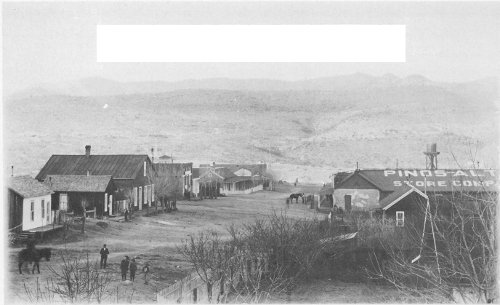
MAIN STREET, 1900. Dr. Robinson, the Robinson and Nolan boys pause to be in picture.
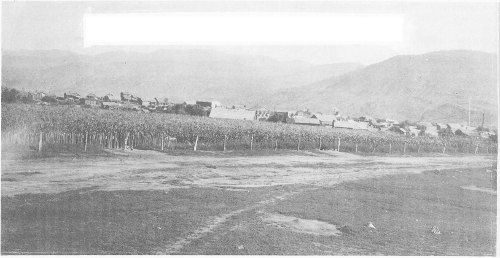
The road leading into town, 1895. Picture taken from crest of Continental Divide. Corn grows on the Potosi Placer Claim.
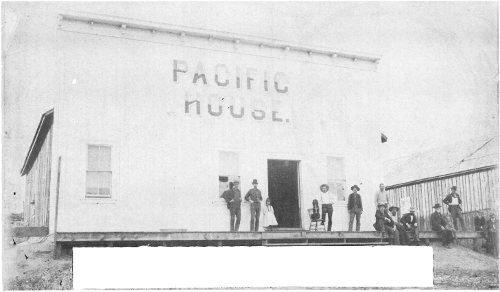
The Pacific House. In the group from left to right are Pat Mullins, John Head, Spaulding’s adopted daughter, the dog, “Wad”, Spaulding and Frank Bell, the first seated figure. Others not recognized.
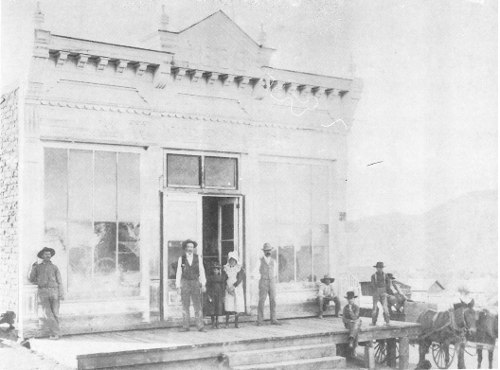
F. J. Davidson bought the Neff Store and operated it until it burned in 1902. It stood in the northeast corner of what was later the Henry Young Orchard. Russell Davidson stands on the porch near door. Later the Davidsons bought the “Old Store.”

The “Old Store.” The adobe part was in constant use from 1868 to 1957.

In the group are Dick Lee, Mr. Welsh, Antonio Montoya (sitting), John Fletcher, Homogon Cuebas. Sitting are two boys who wandered by and Victor Davidson and Allan Box.
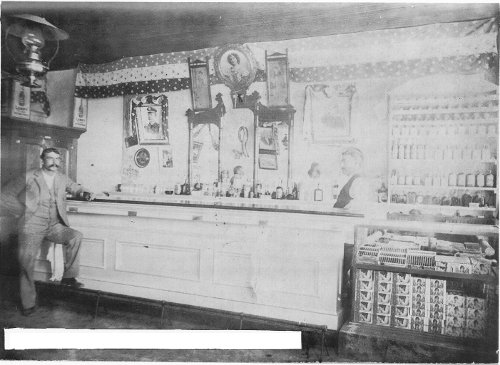
The bar of the Cave Saloon about 1900. Mr. R. E. Lee, proprietor.
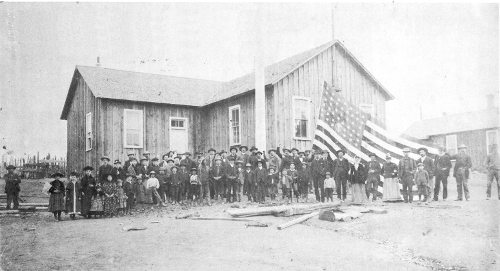
The flag was raised for the first time on the new pole in front of the second school building, Feb. 22, 1889.
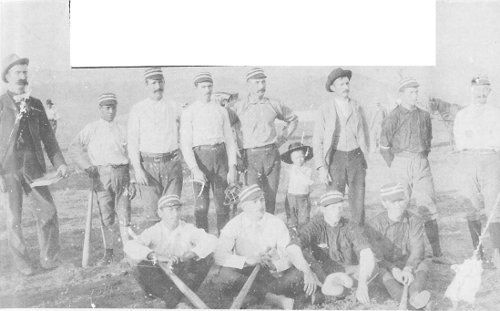
A ball team about 1890. Back row, Bill Christman, ——, George Husband, Herb Robinson, Jack Nolan, Dan Nolan, Dr. Robinson, Ed Kayler, Jackie Minear. Front row, ——, ——, Joe LeRoy, Joe Adair.

Girls’ Basketball Team, 1902-1903. Claire Scott, Dorothy Watson, Mary Lee, Clara Upchurch (Trevarrow), Alice Scofield, May Marks, Alice Legros, Jennie Fox.

A group of picnickers at Mill Creek in the fall of 1892. From the back row, reading from left to right are: Gertrude Trevarrow (Dimmick), Mrs. Trolius Stephens, ——, Mrs. Nat Bell, Mrs. Watson with Dorothy in lap, George Bell, Bert Stephens, Chan Derbyshire with Harry Watson, Joe Arnheim, Harry Williams, Mrs. Arnheim, Mrs. Williams, Henry Stanley, Frank Stephens, Frank Brito, Mr. McLean with Artie Williams, ——, W. E. Watson, Mrs. McLean, a Mr. Bell, Golden Bell.
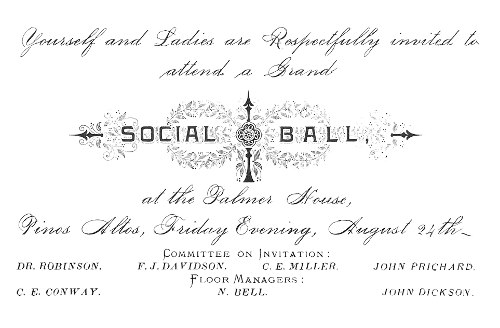
An invitation issued in 1888.
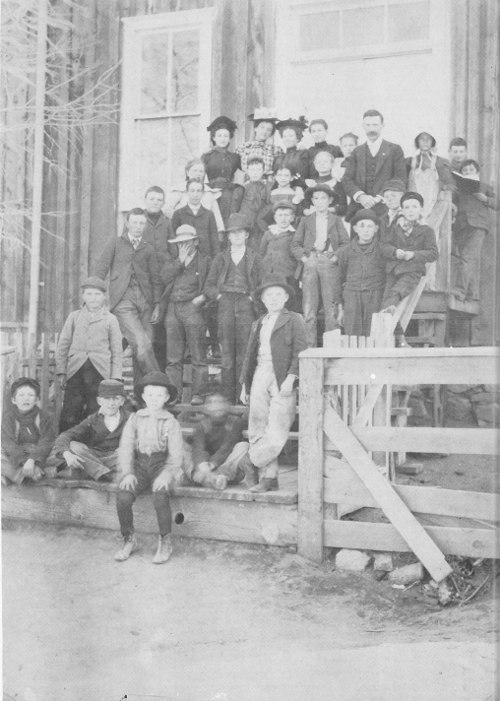
Upper grades, Pinos Altos School, 1901-1902. Top row: Ernestine Marks, Bessie Harwell (Young), Eva Ratcliff, Mary Lee (Bloom), Alice Legros (Huff), W. H. Decker, Principal, Grace Head (Smith), Louis Marks, Zack Bellhouse. Second row: Dorothy Watson, Marie Pound, May Marks, Lillian Jackson (Forsyth). Third row: Henry Geitz, Gordon Davidson, Harry Watson, Mike Hughes, John Clark, Lyman Trevarrow, Alex Thomas. Fourth row: Fred Pound, Tom Phillips, Dan Nolan. Fifth row: ——, Herbert Herman. Sitting: Frank Mullins, Bob Ratcliff, Leslie Herman, ——.
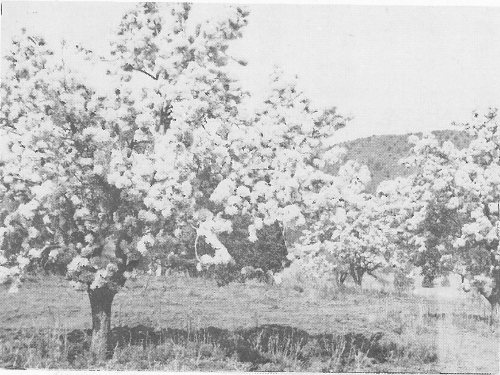
Apple trees blossom where corn once grew.
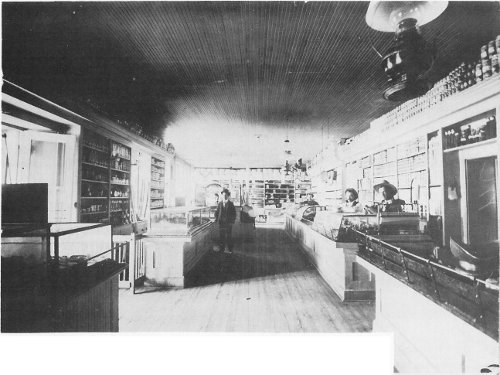
The interior of the “Old Store” during the Hearst days. From left to right: Tommy Hall, Will Rivers, George Turner, Sidney Derbyshire.

The Davidson families and two guests from Nova Scotia on the porch of the F. J. Davidson home, 1902. Back row: Mr. F. J., his son, Gordon, Mrs. F. J., Mrs. Russell Davidson, Victor, Claire Scott. On steps: Mr. Russell Davidson, his three children, Robert, Dorothy and David, Mrs. Forbes.
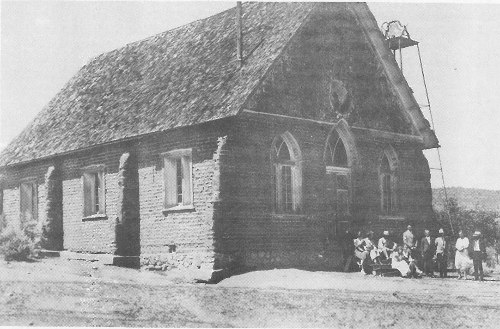
In 1942 Rev. Henry Van Valkenburgh and his family visited the church he had served as pastor, 1898-1902.
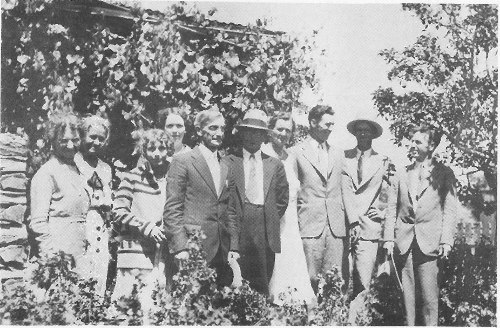
At the Young home, 1942. Mrs. Van Valkenburgh, Mrs. Hunt, the Vans’ daughter, Oleta Young, “Brother Van,” Henry Young, Mrs. Young, Vans’ son-in-law, “Young Henry”, J. G. Hunt.
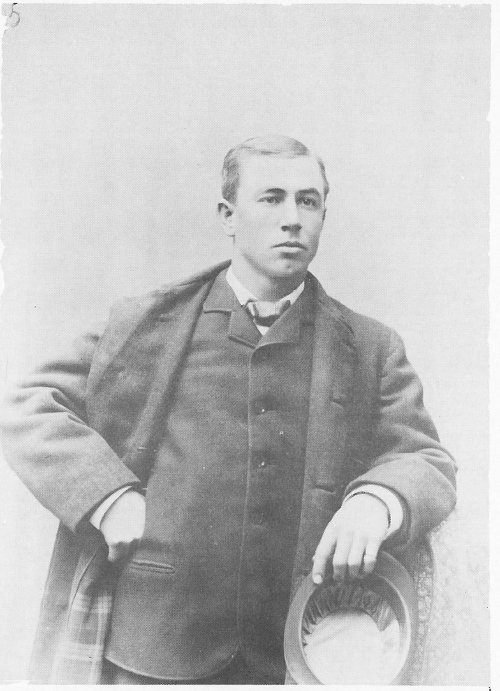
William E. Watson as he looked when he left Wisconsin to come to New Mexico in 1878.
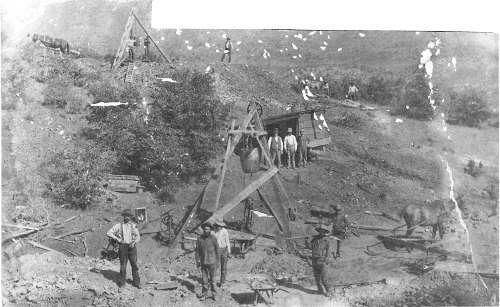
This is the site of the first lode claim, the Pacific. Mining in this manner from these mines yielded nearly one million dollars in gold between 1881 and 1889.
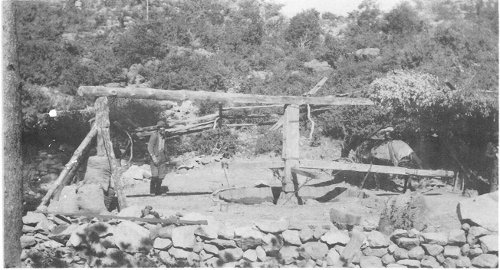
Jake Long and Arrastra on the Oceola during the ’80’s.
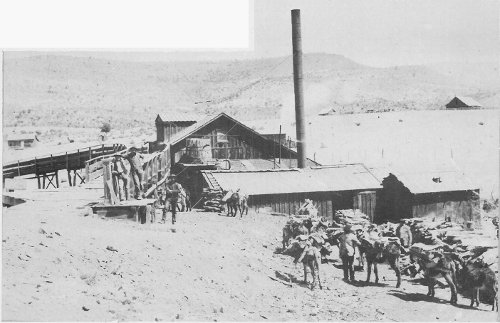
The Skillicorn Mill, later called the Stanley Mill, 1889.
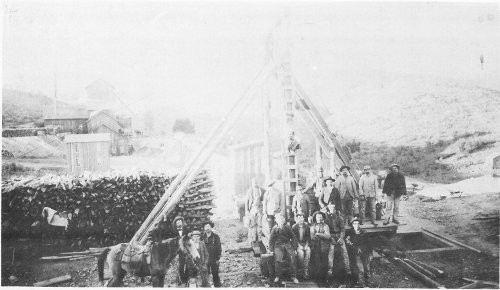
The Atlantic Mine in 1890 with the Deep Down Mill and bunk house in background. W. E. Watson, Willie Towatha and Walter Brandis standing near horse.
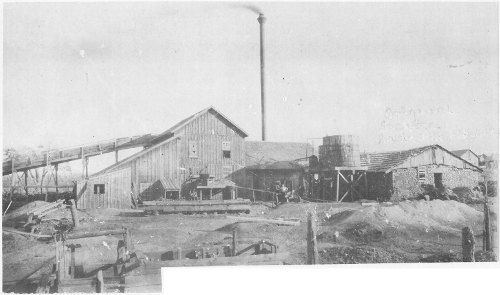
The Bell and Stephens’ Mill as it looked from 1882-1890 from the Bear Creek side. The stone part was the original Ancheta Arrastra Mill, 1868-1882.
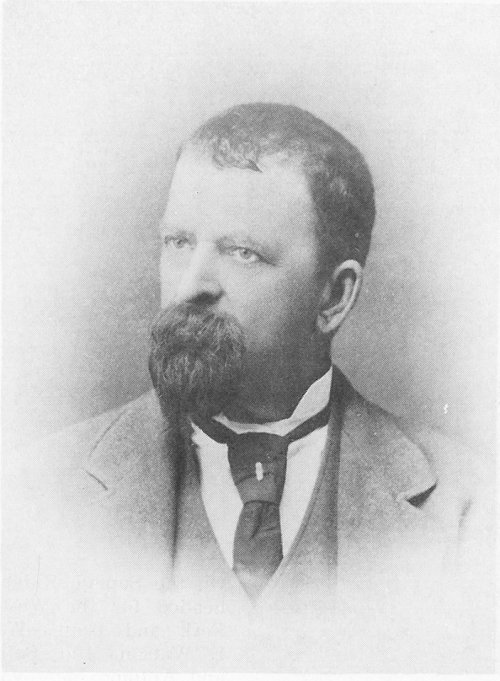
Trolius Stephens, 1896
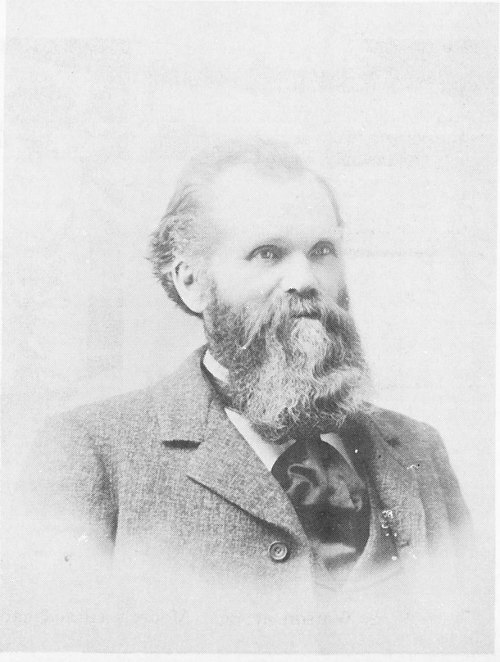
Nathaniel Bell, 1896
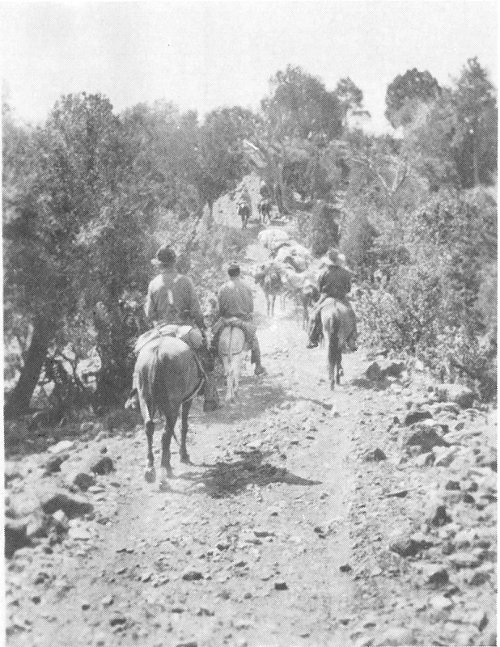
On the Sapello Ridge headed for the West Fork and trout. W. E. Watson, Jim Bell and Antonio Montoya bring up the rear.

W. E. Watson at Bear Moore’s ruined cabin on the West Fork.
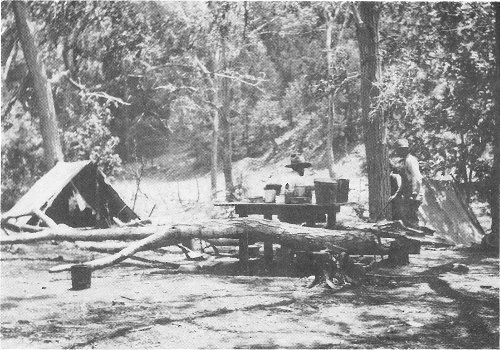
A placer miners’ camp on Bear Creek.

Stragglers on the last big cattle drive through town.
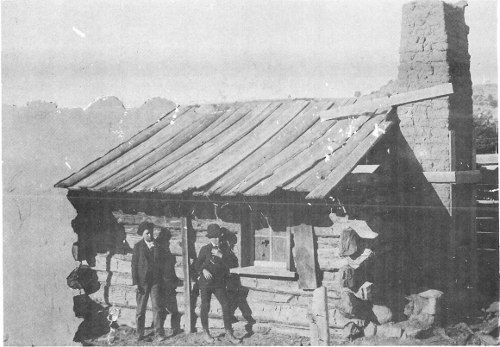
Trolius Stephens brought his wife to this cabin in 1873. Before it was torn down in 1895 Mrs. Stephens insisted that Bert and Frank be photographed beside the house in which they had been born. Neither looks as if he aspired to be president.
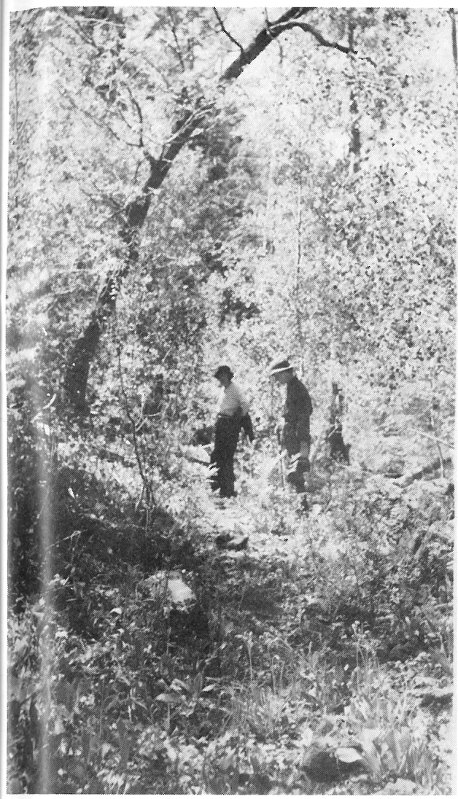
Dr. Nesta Thompson and Mrs. Henrietta Vincent, of the college faculty, 1938, enjoy a trail in the vicinity of Black’s Peak.

Nell Hunt and Jo Ryan rest after climbing Signal and Black’s Peaks. The old tower in background.
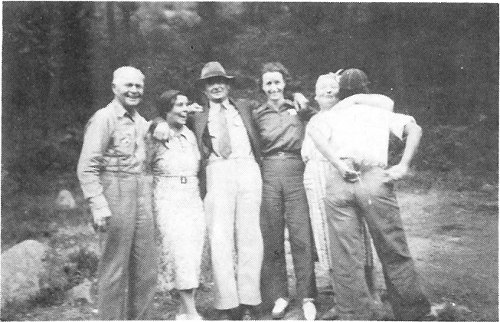
A picnic in Big Cherry is a “must” when former residents return for a visit. Joe Janes, Margaret Bell Leasure, Henry Young, Jean Watson Eckard, Nell Robbins Miller with Josephine Bell Ryan with back to camera.
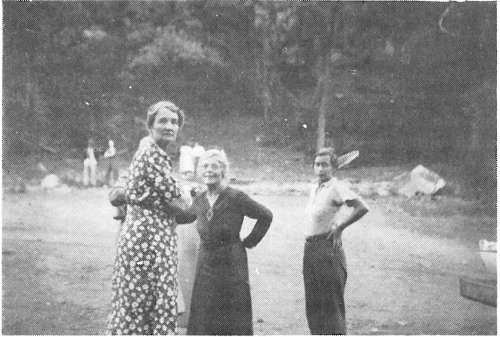
Same picnic with Mrs. Young, Mrs. Janes and Mrs. Harry Hickel in foreground.

First Excursion on the Silver City, Pinos Altos & Mogollon R.R., January 1, 1906.
